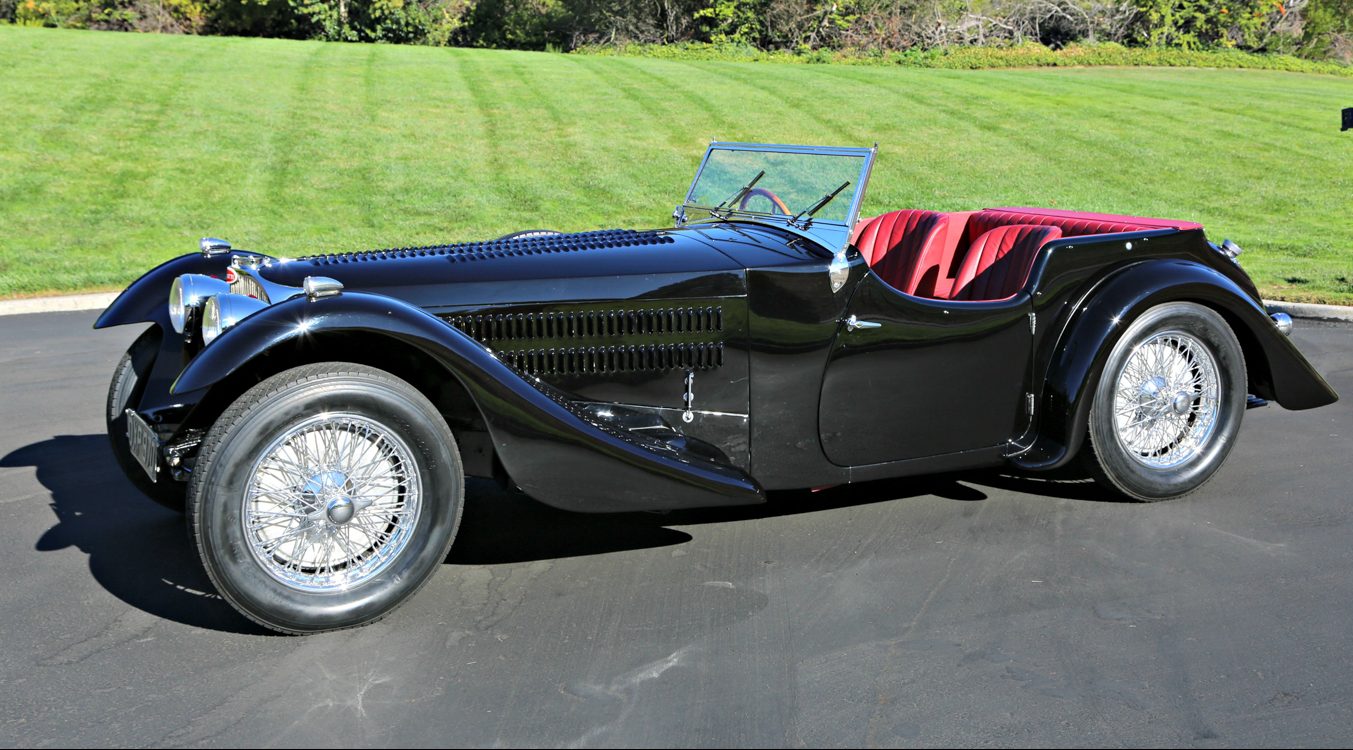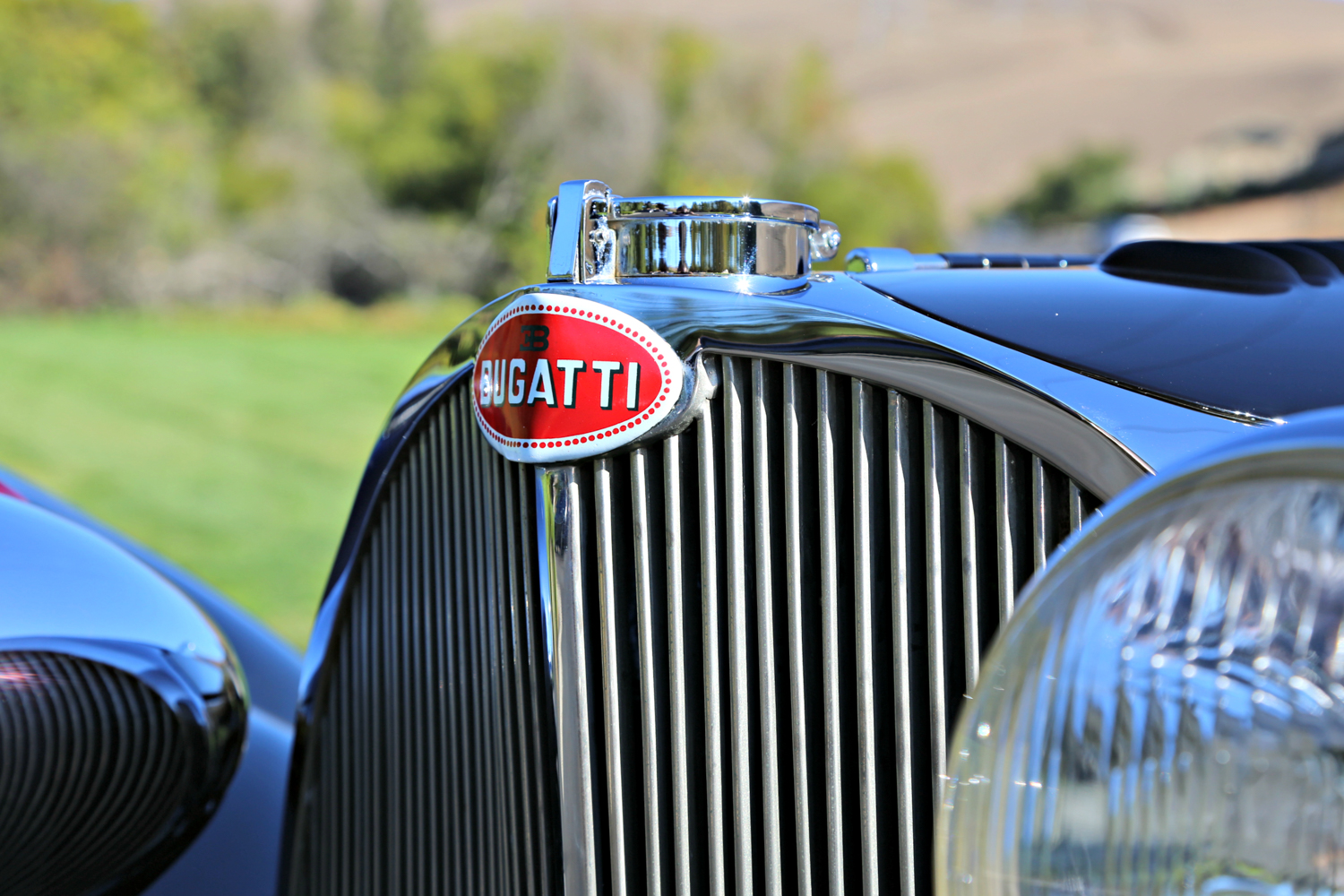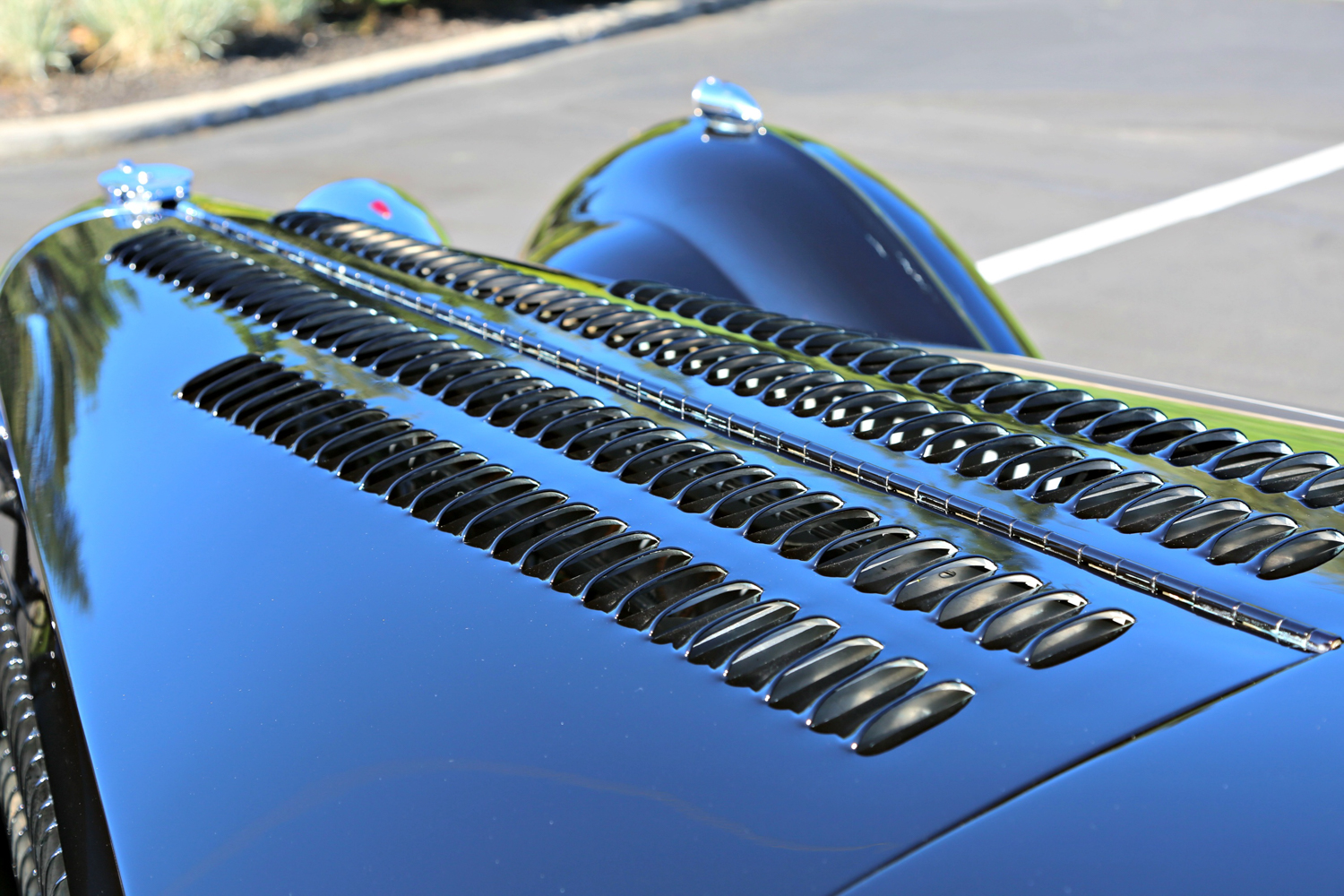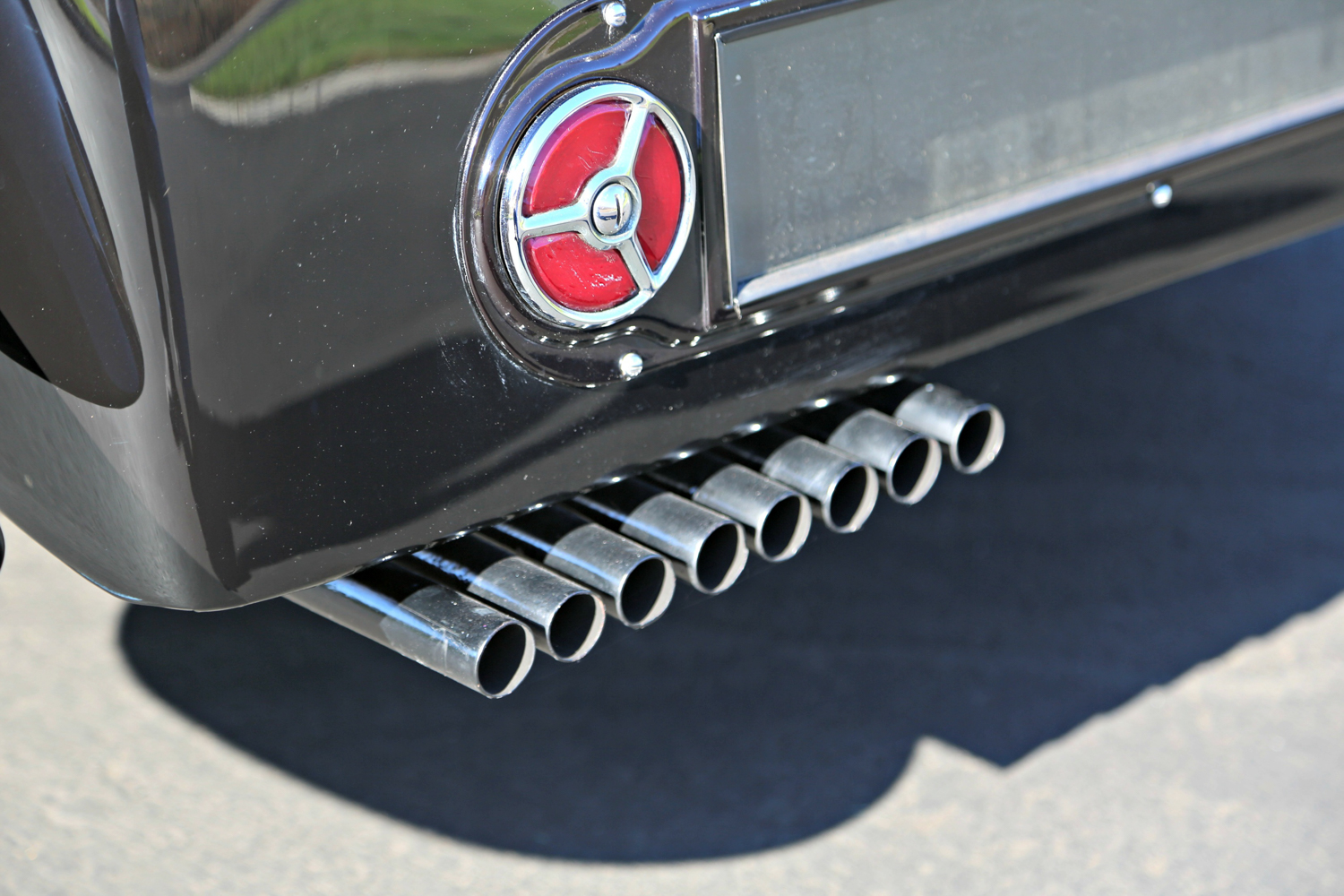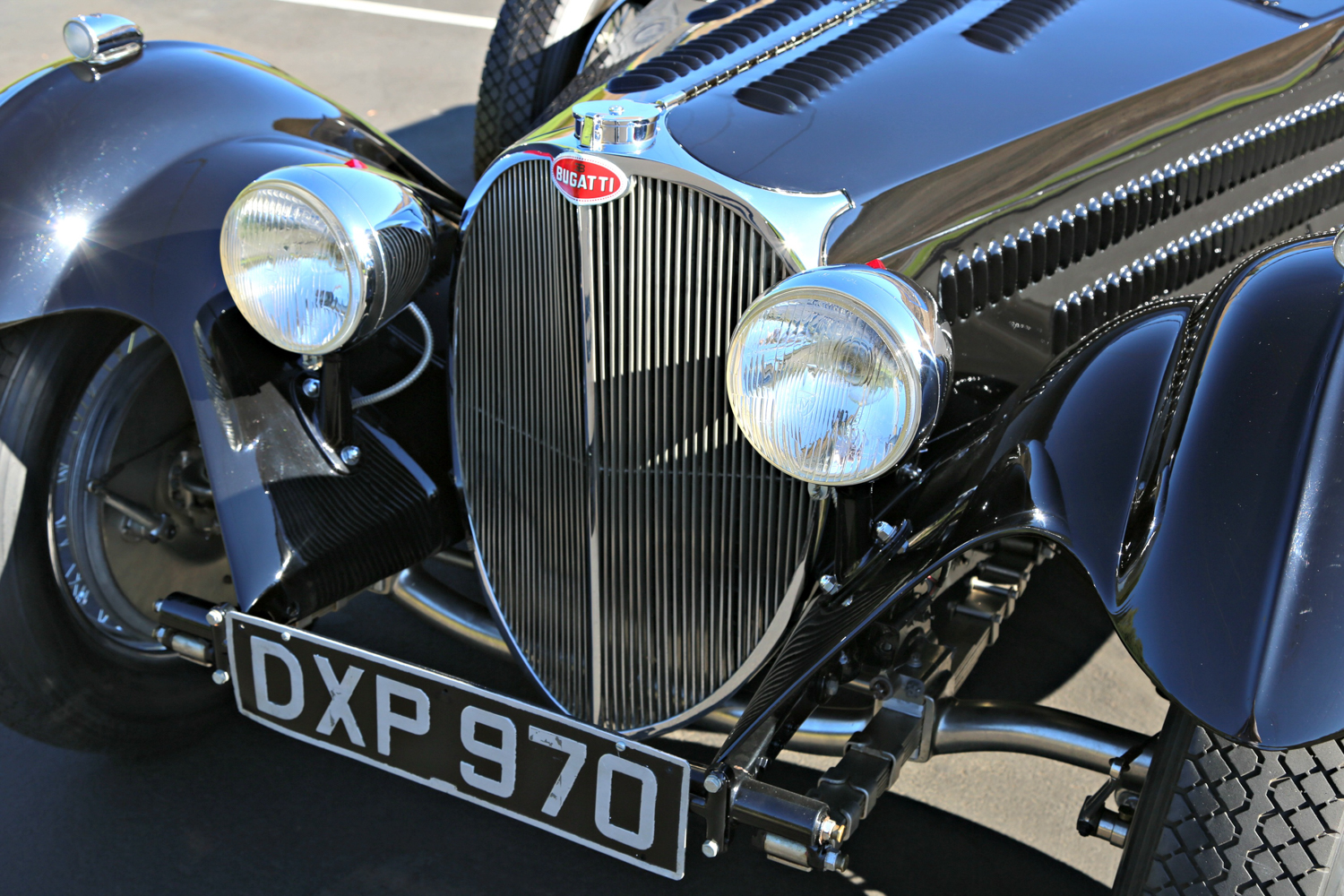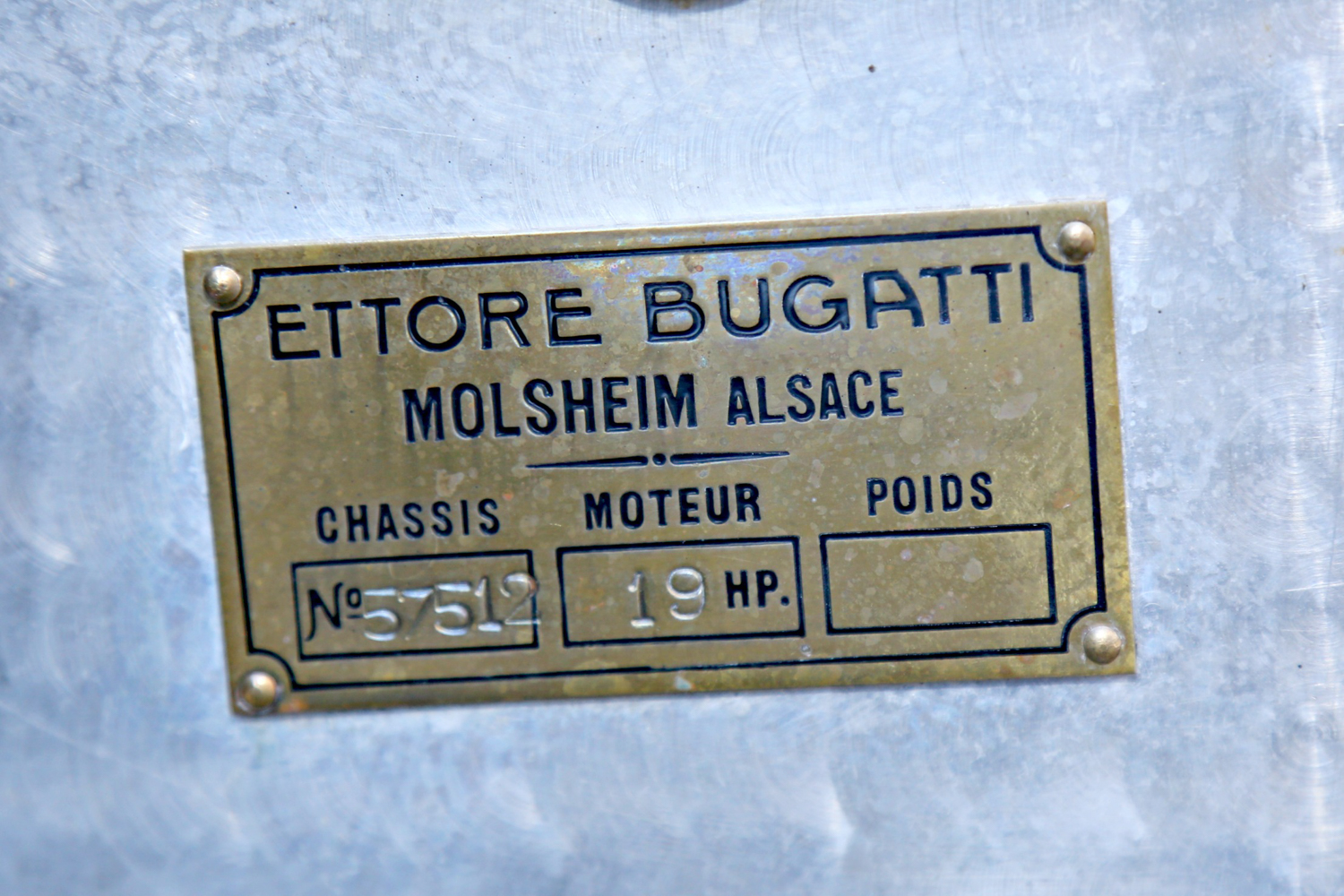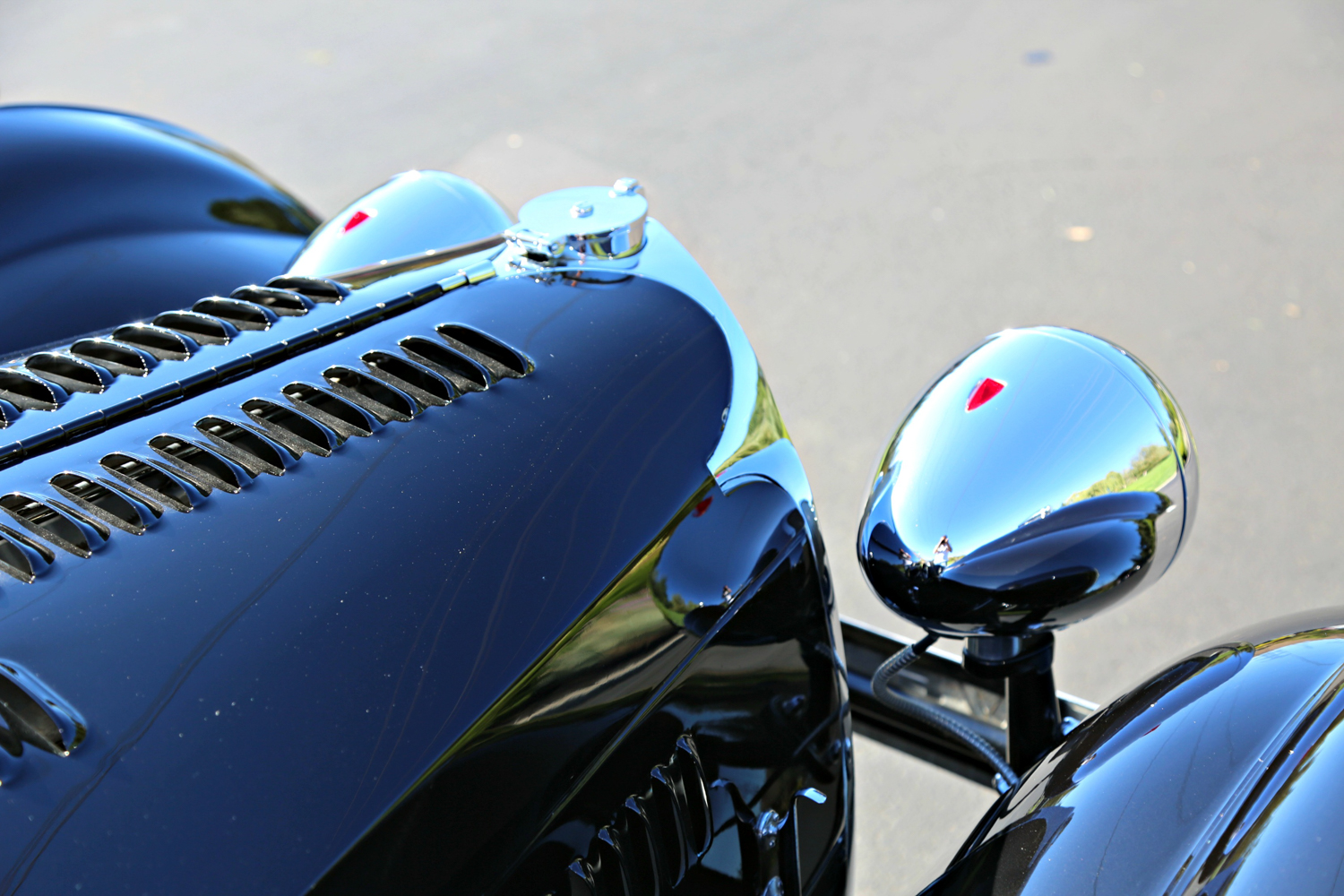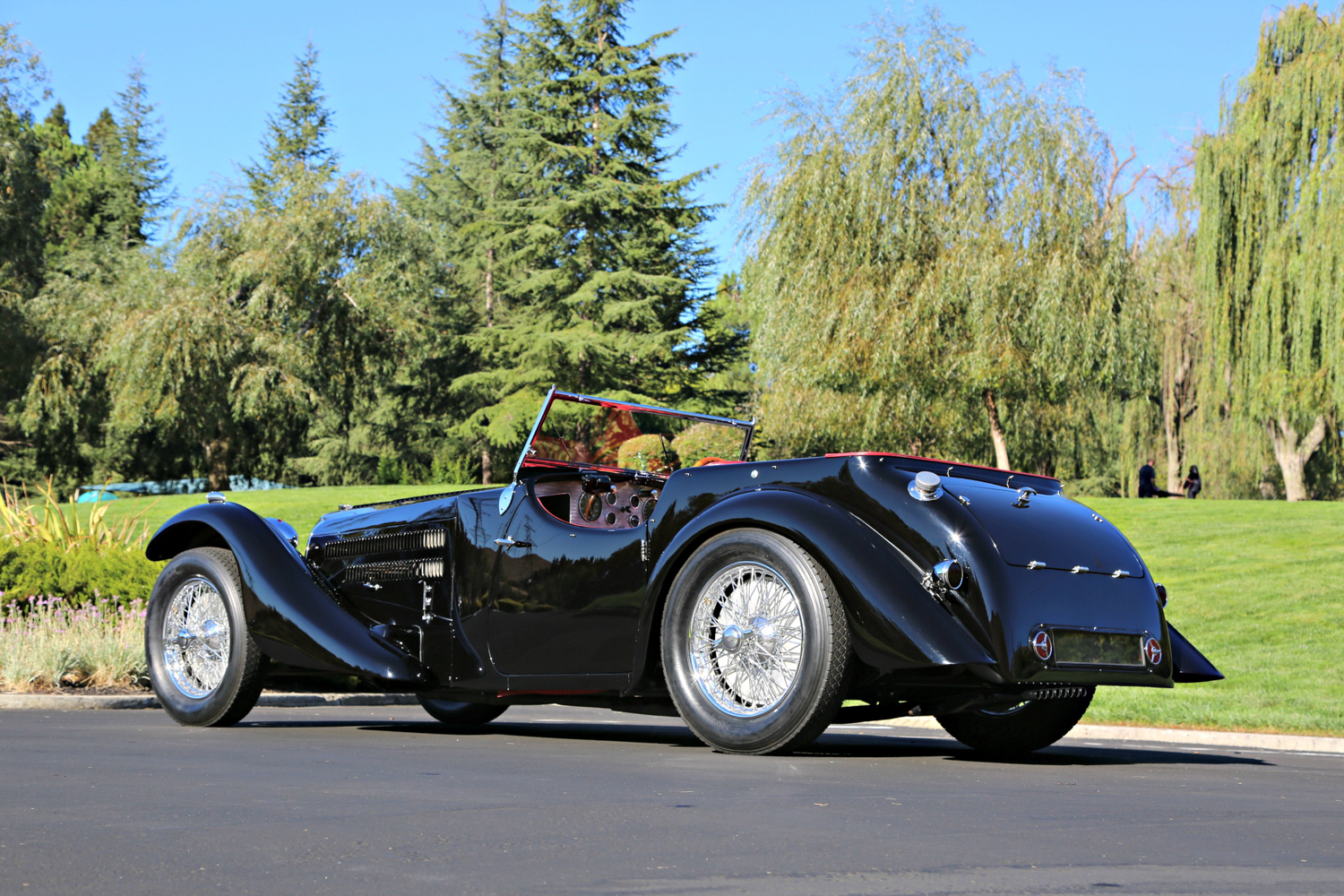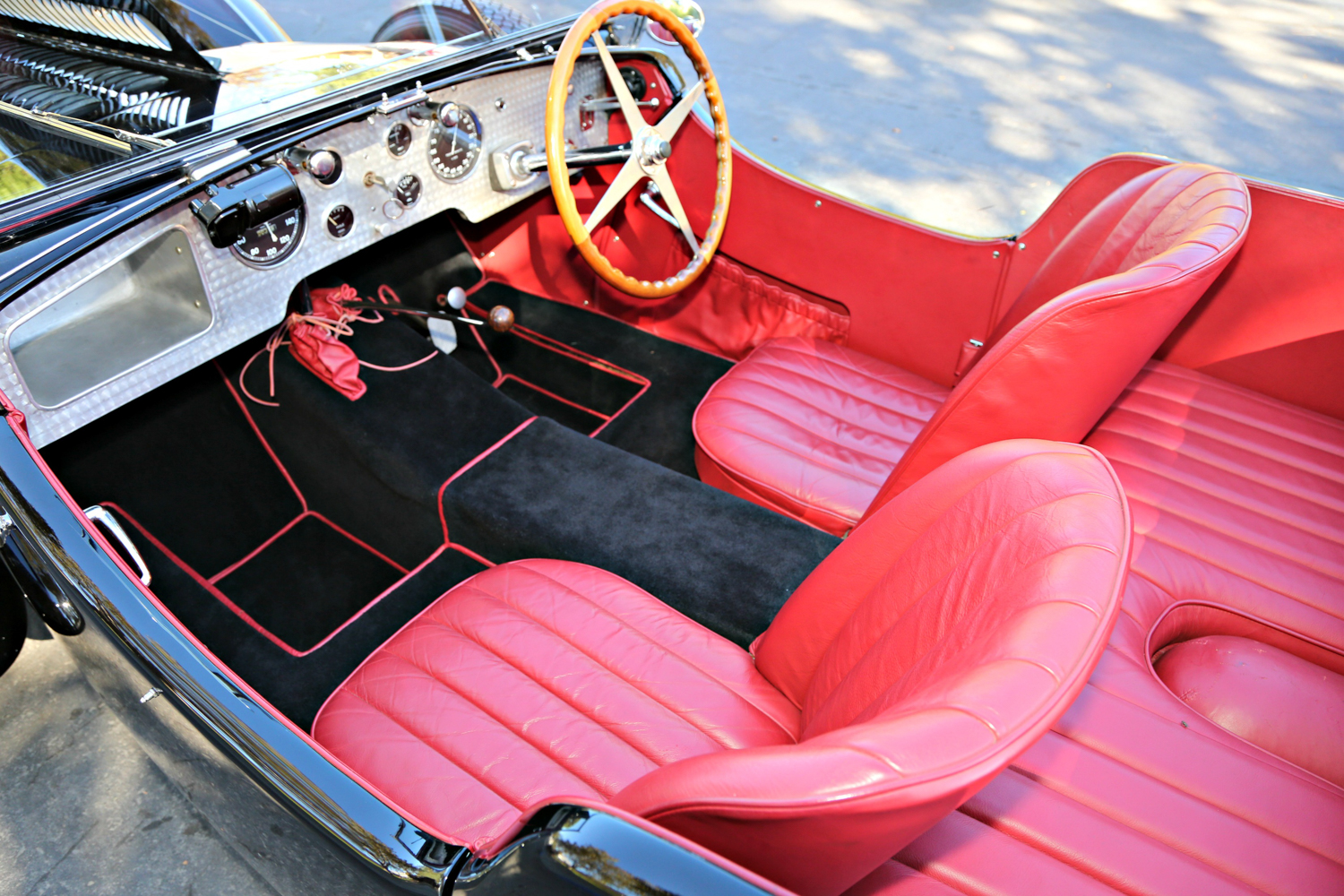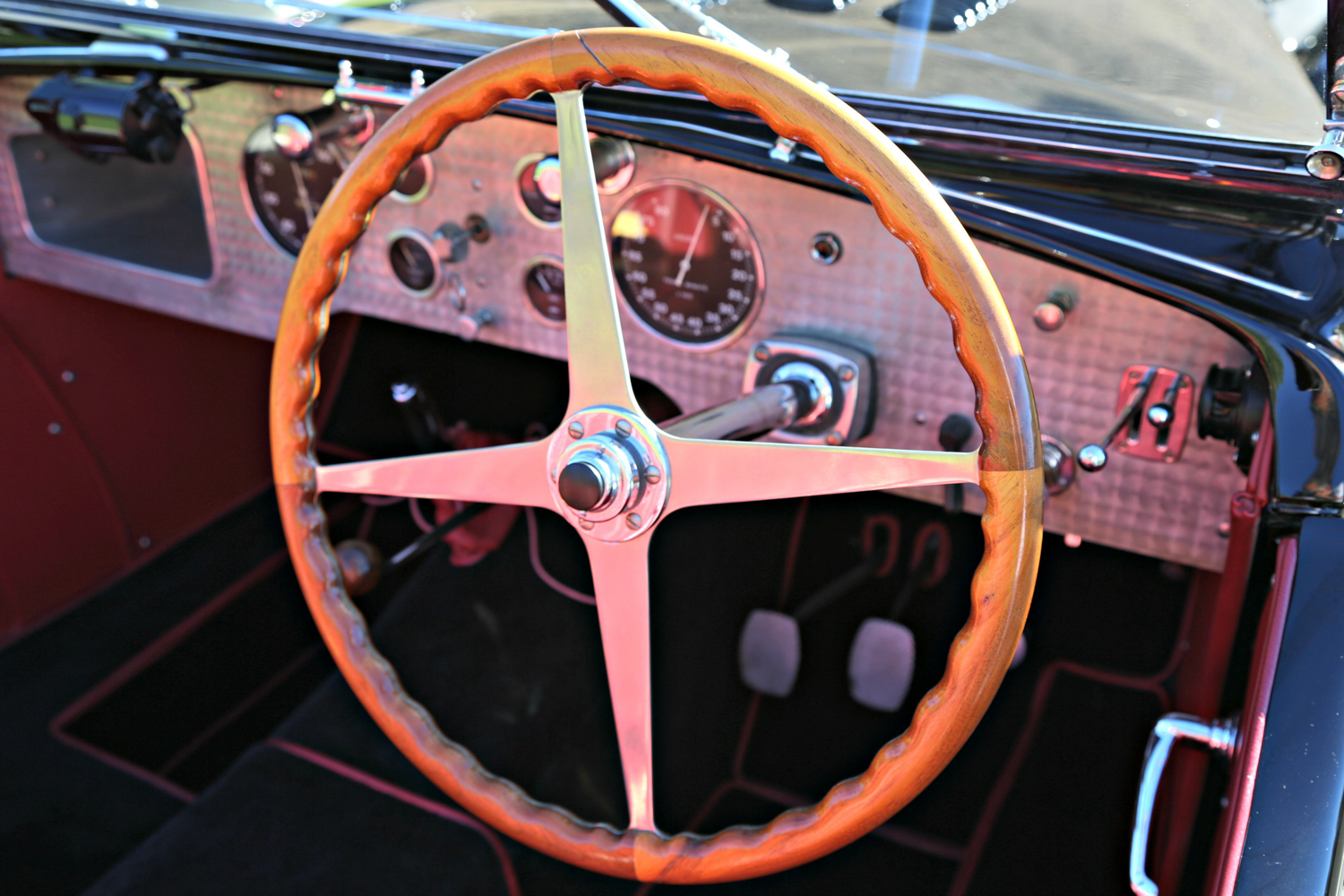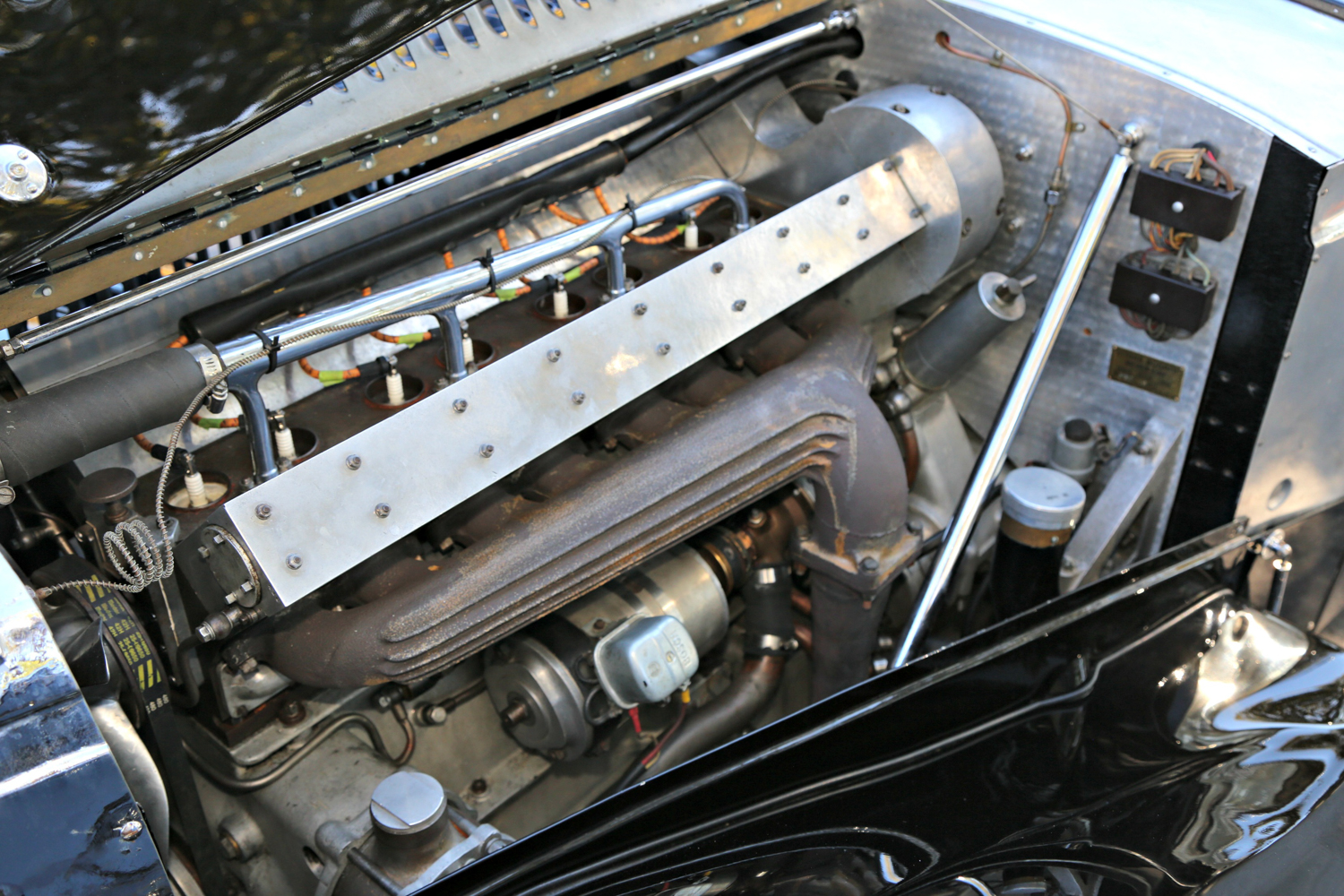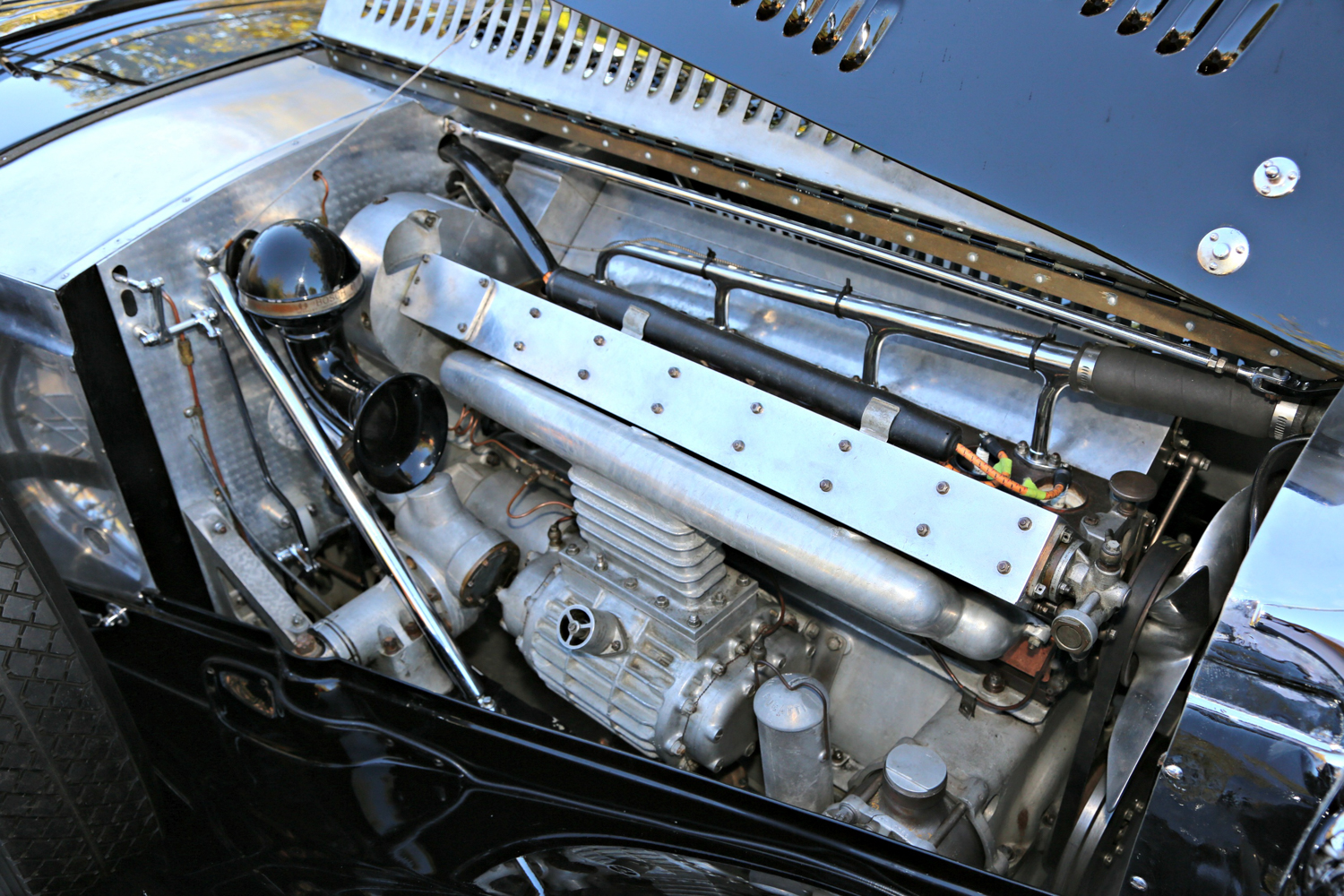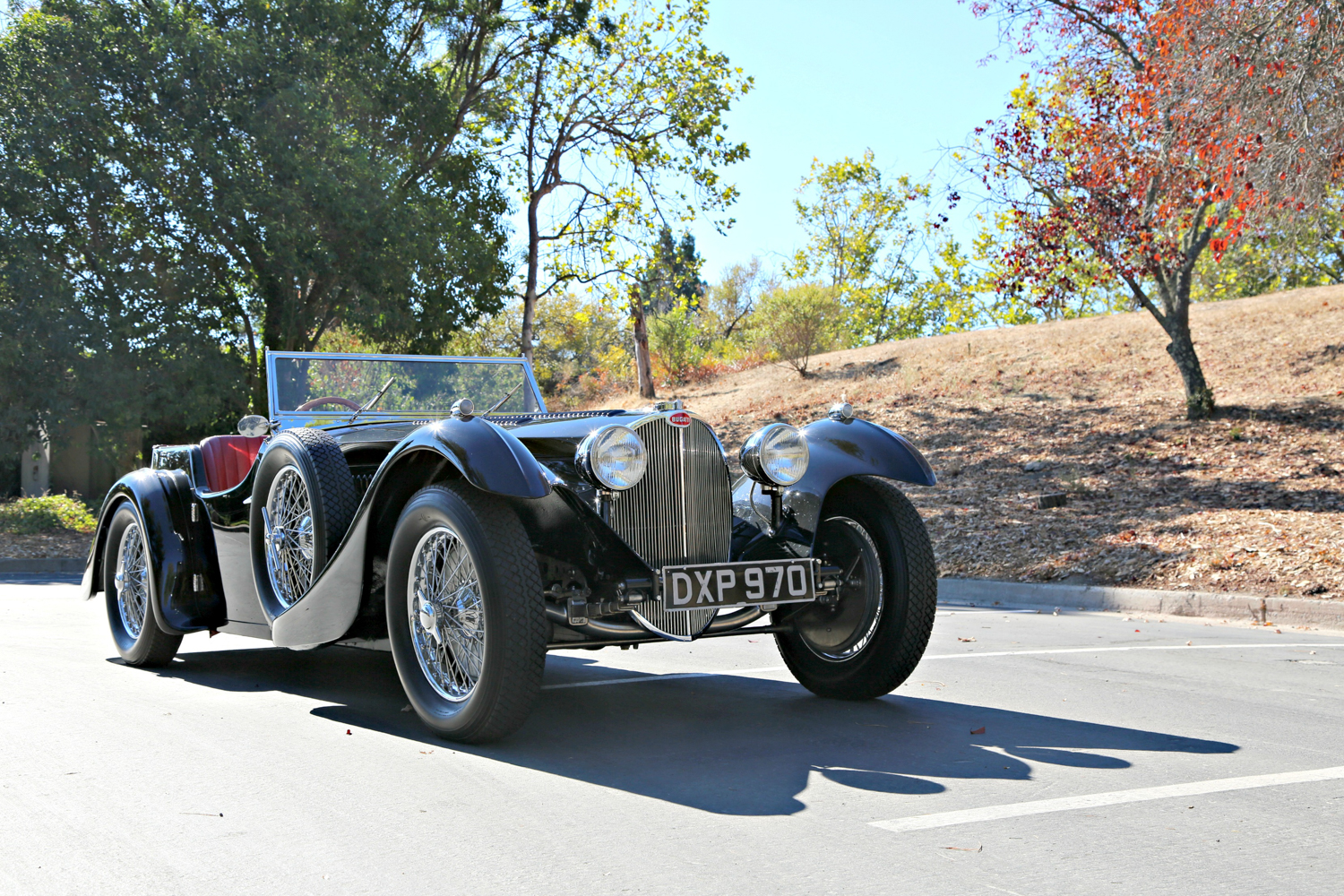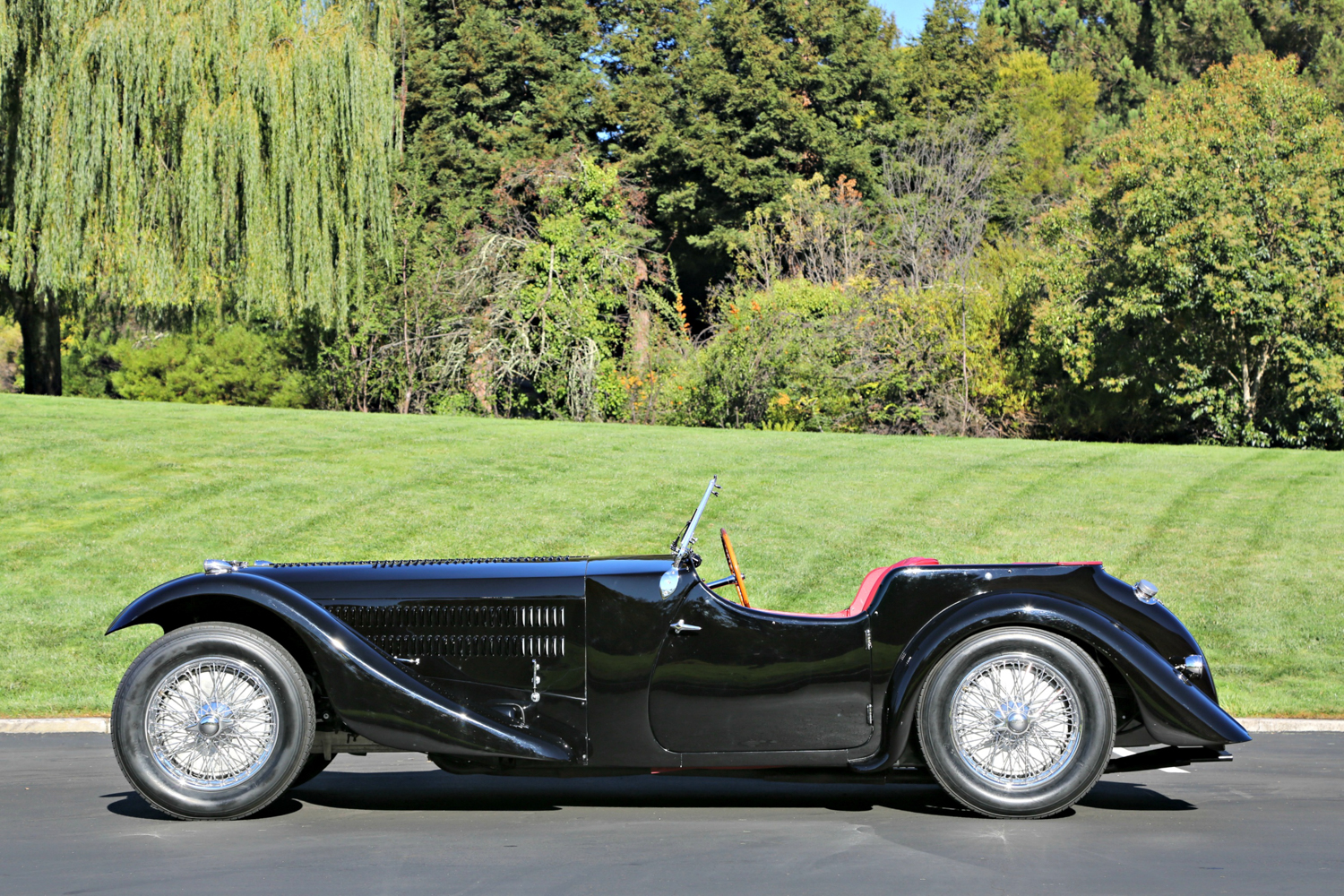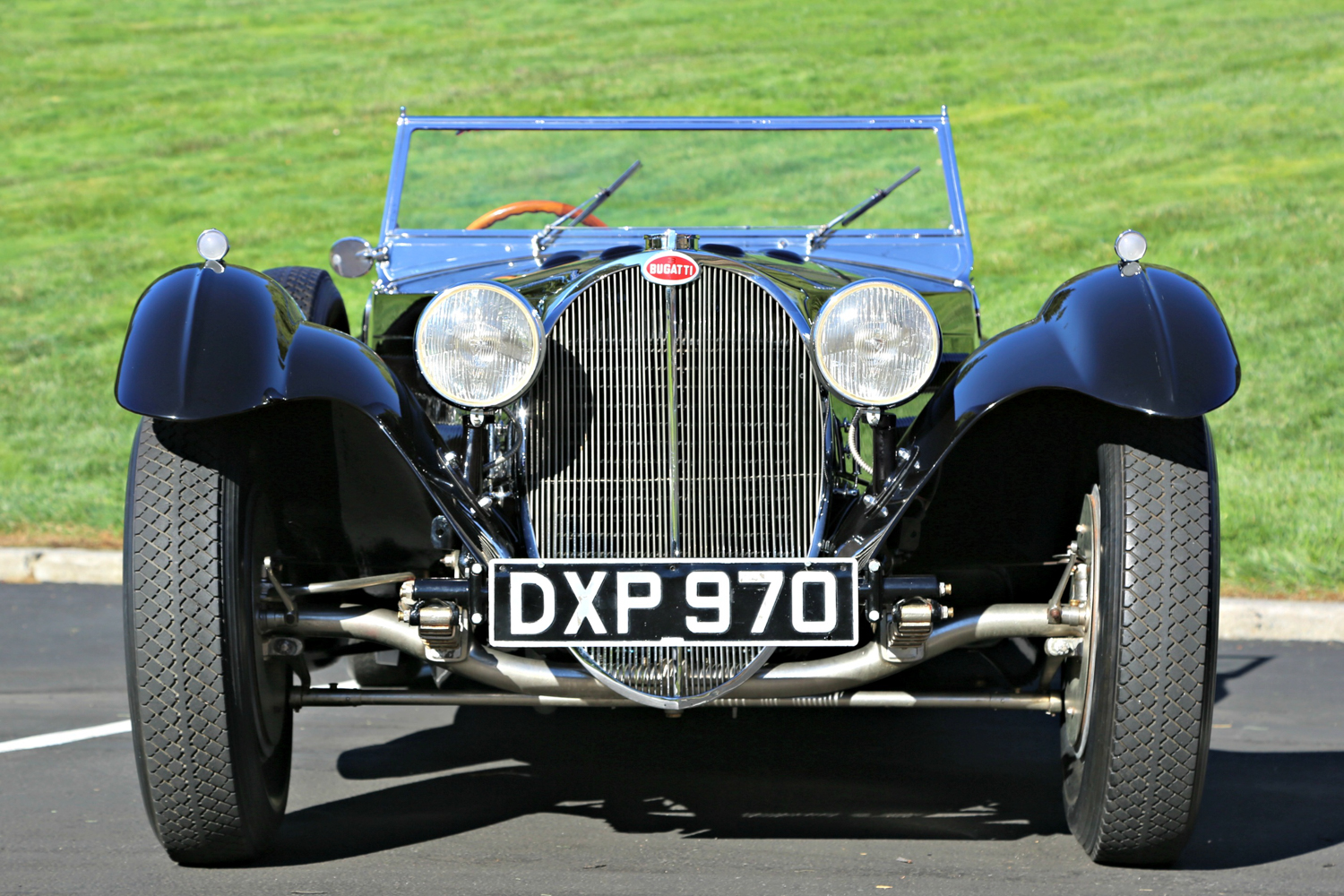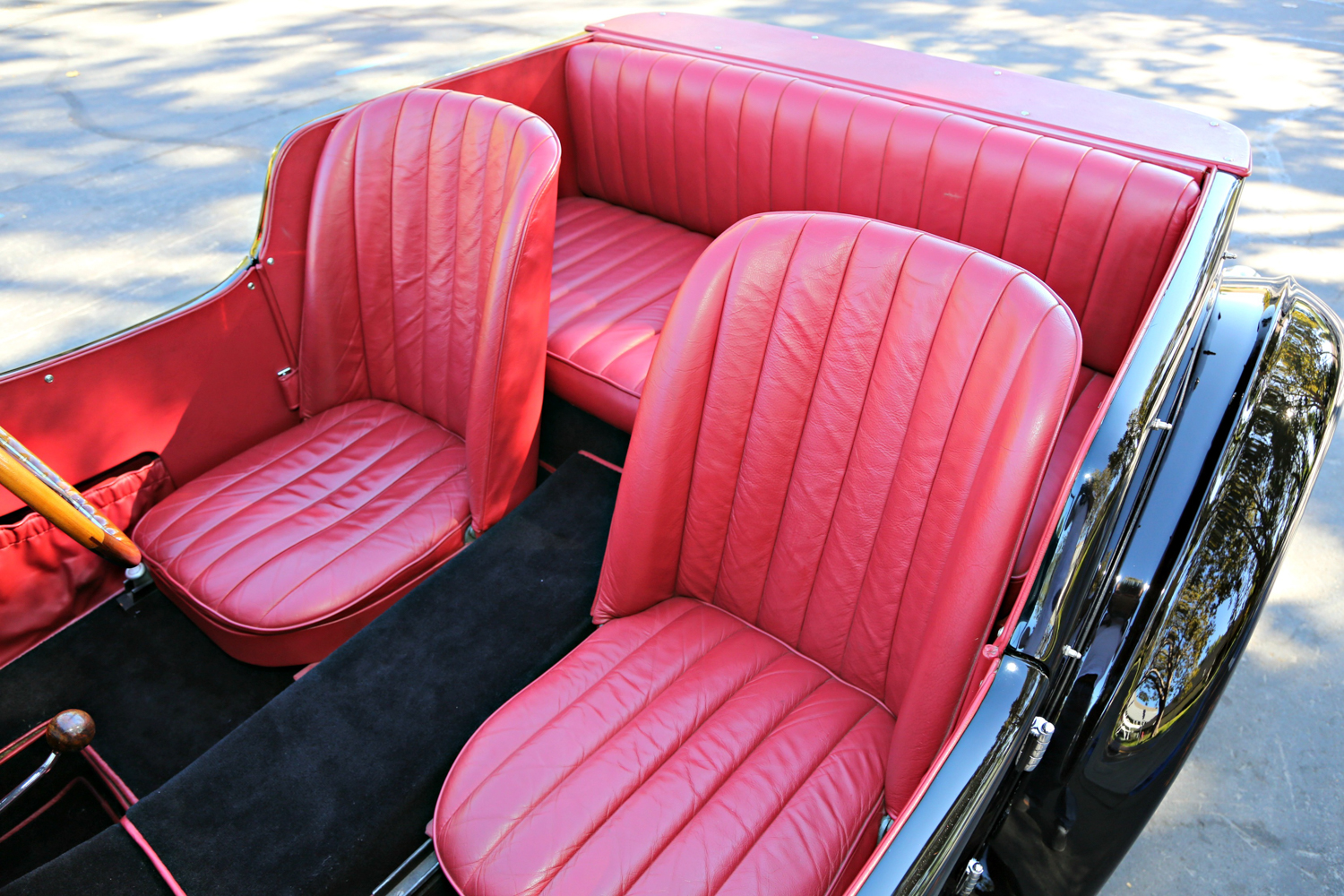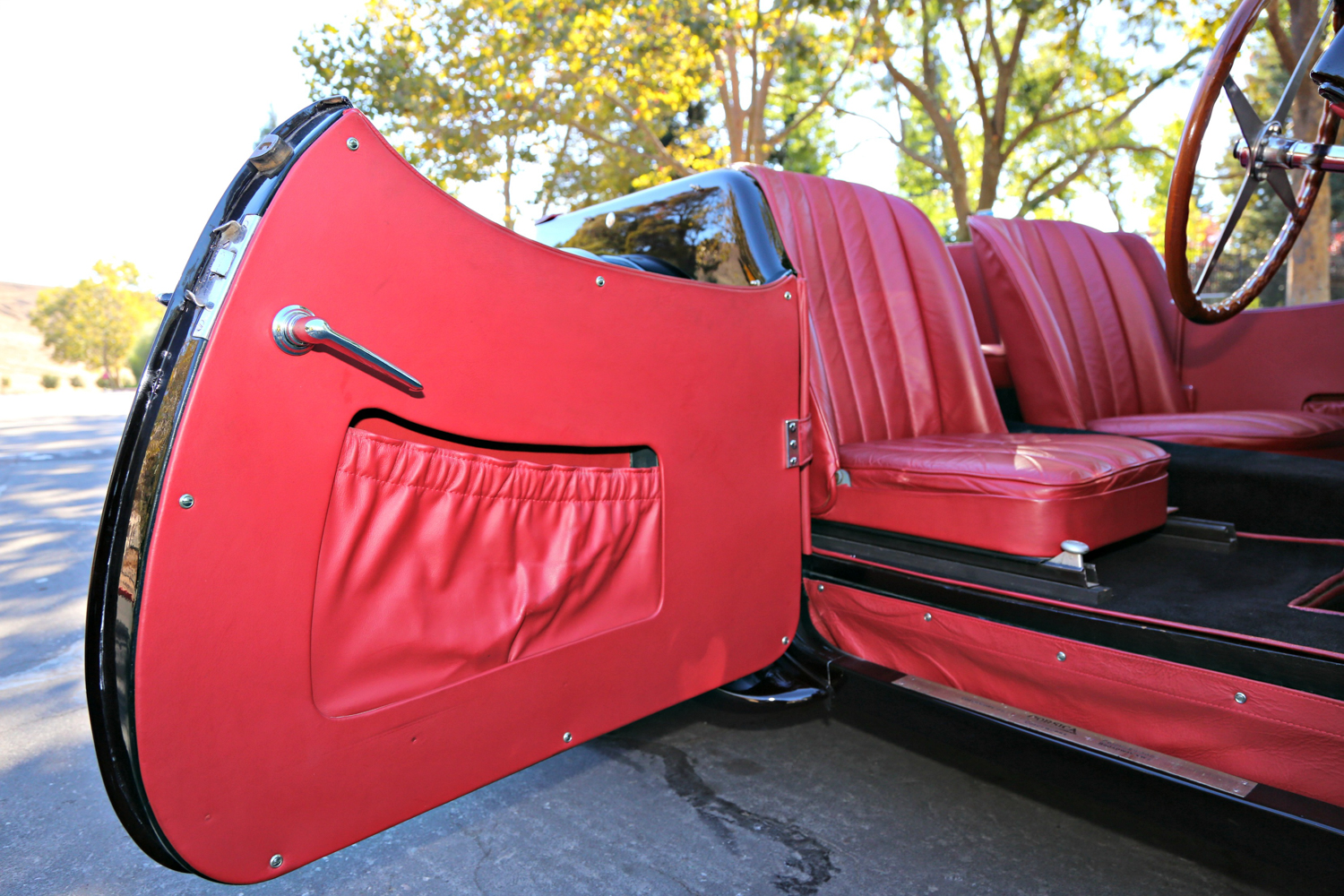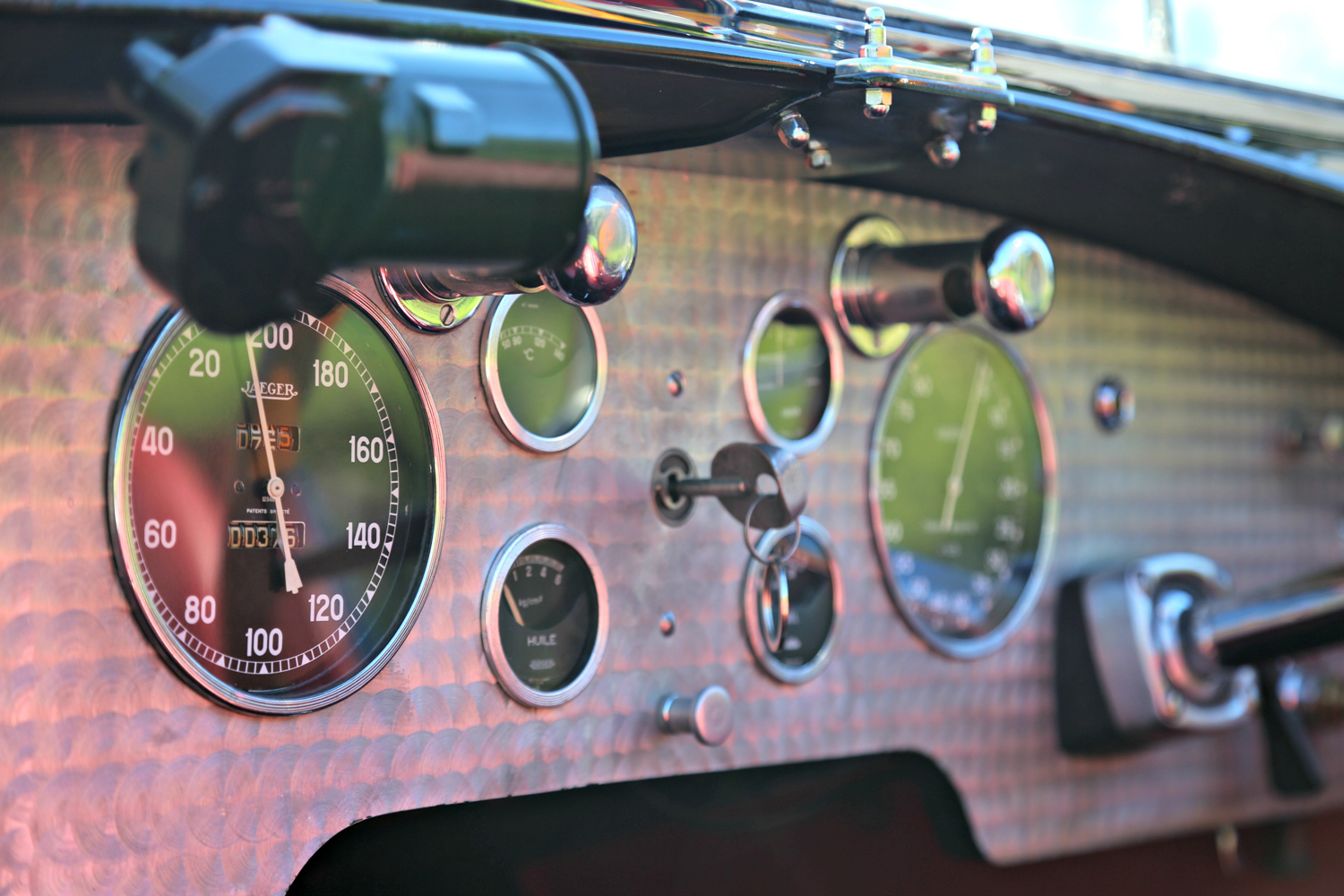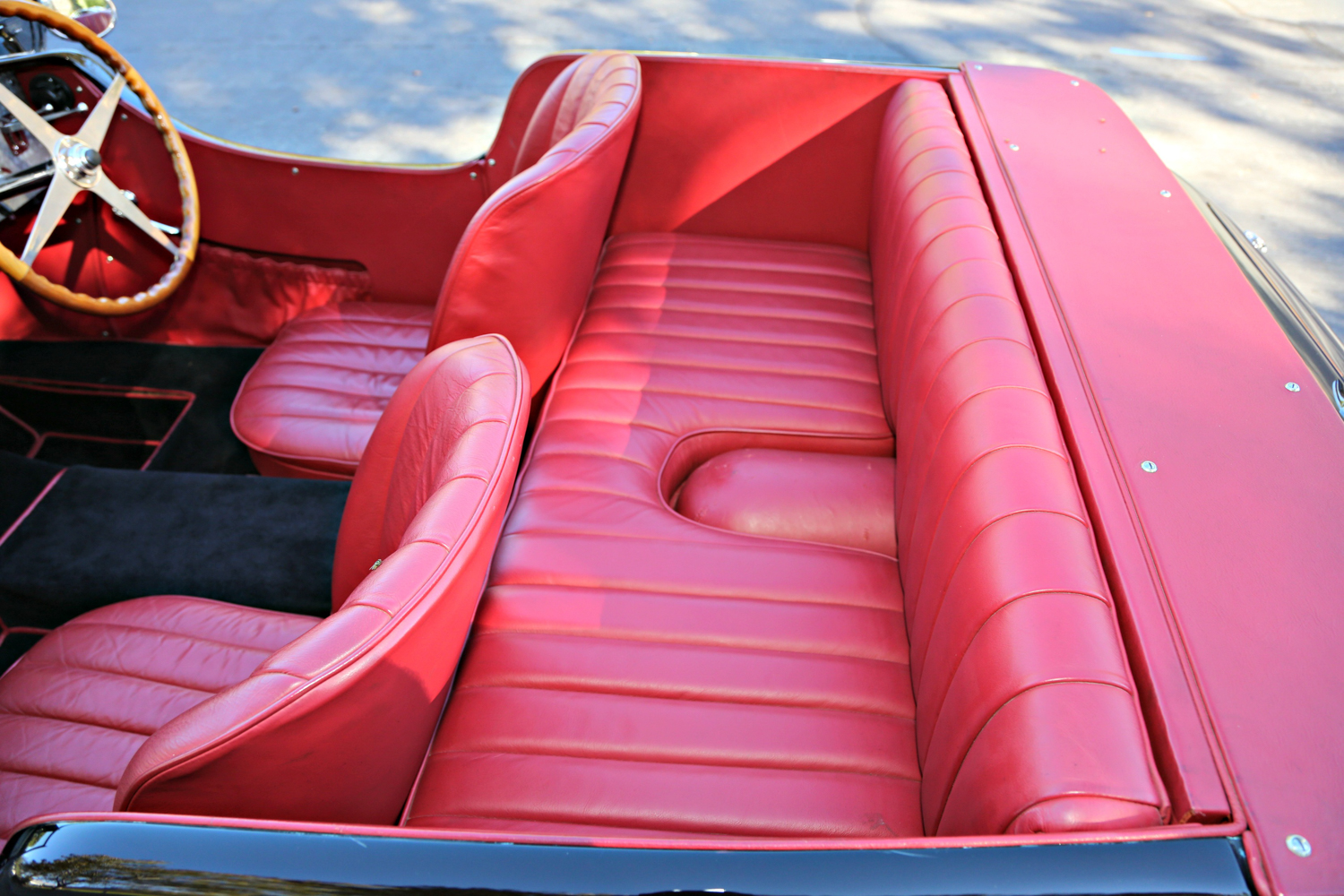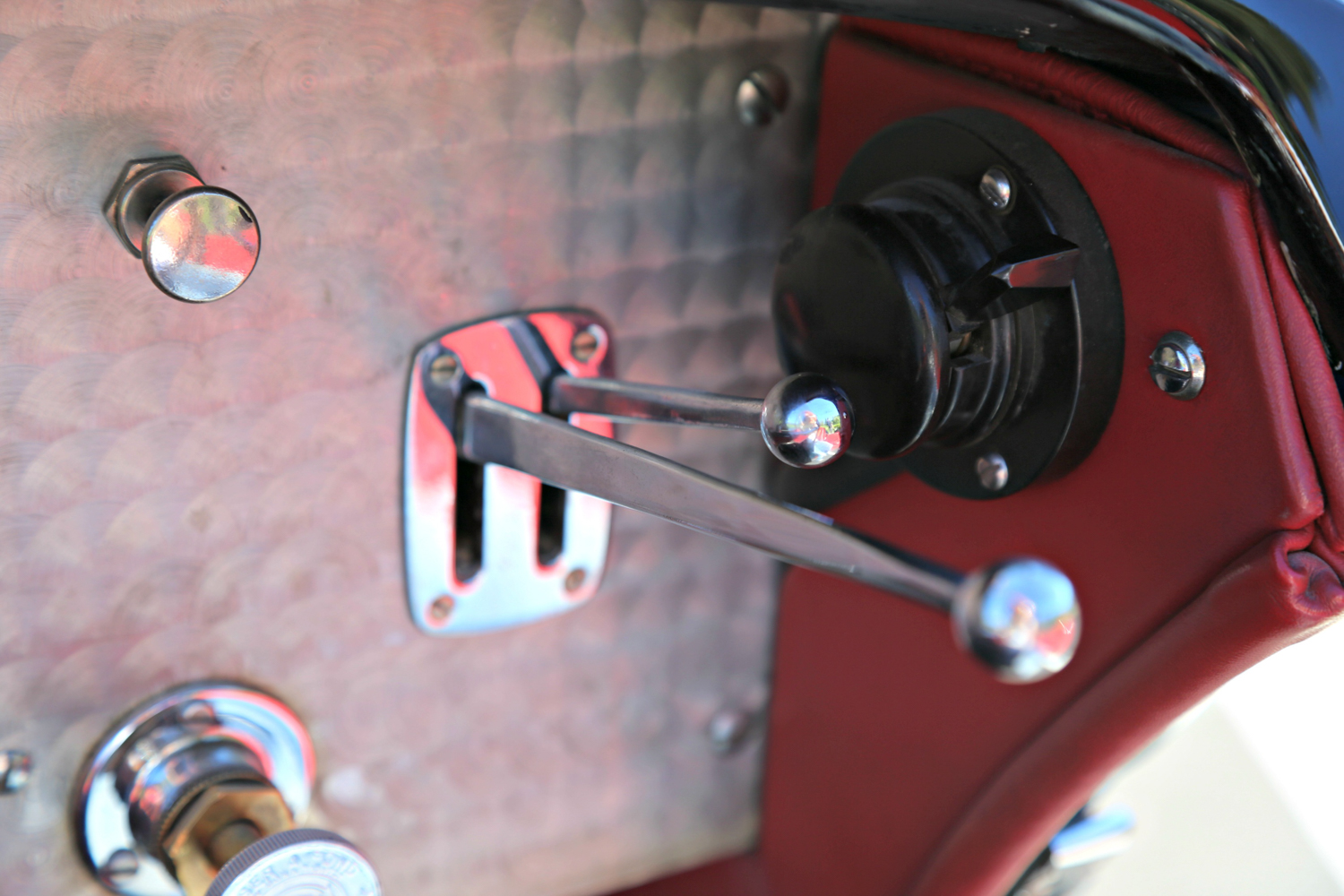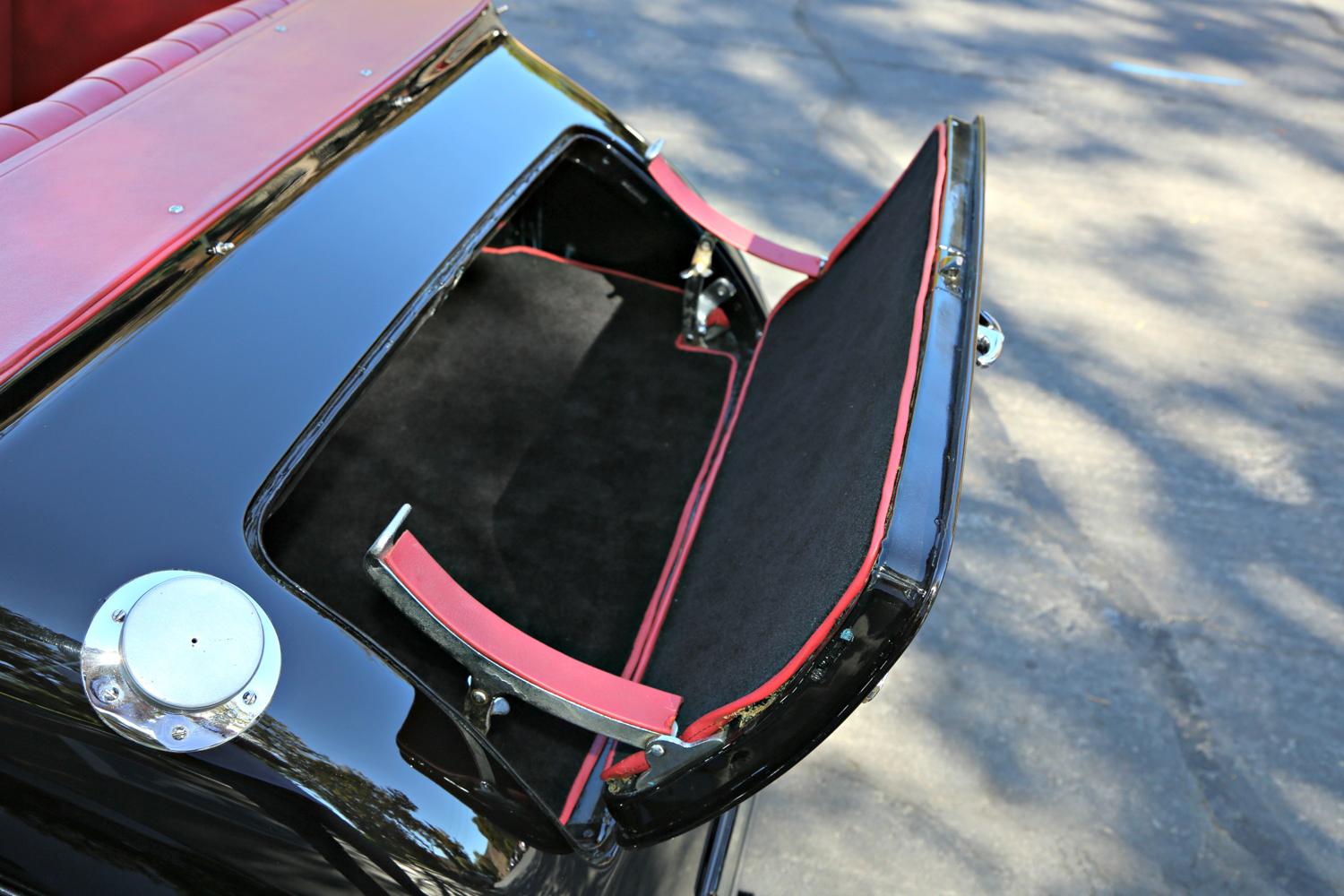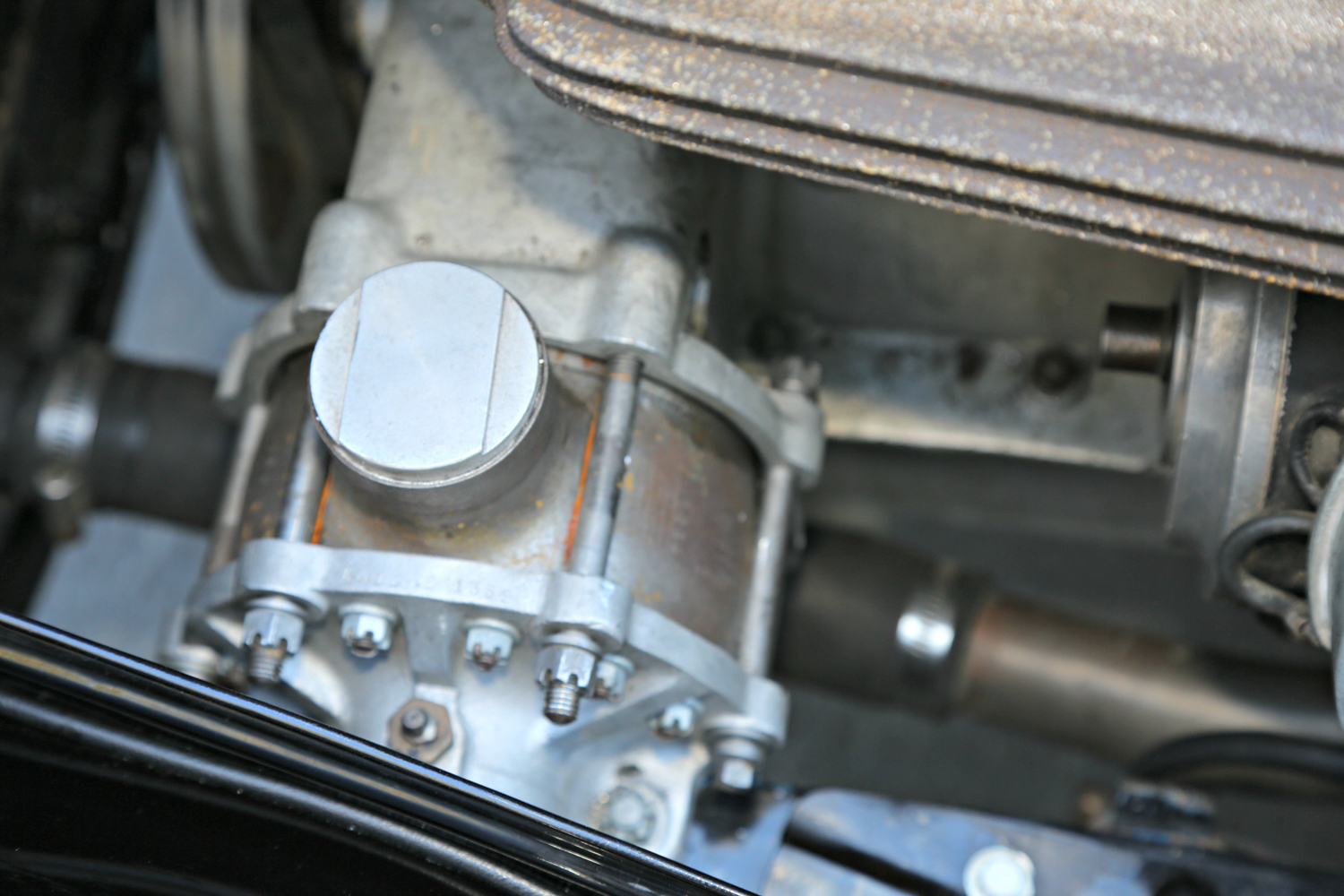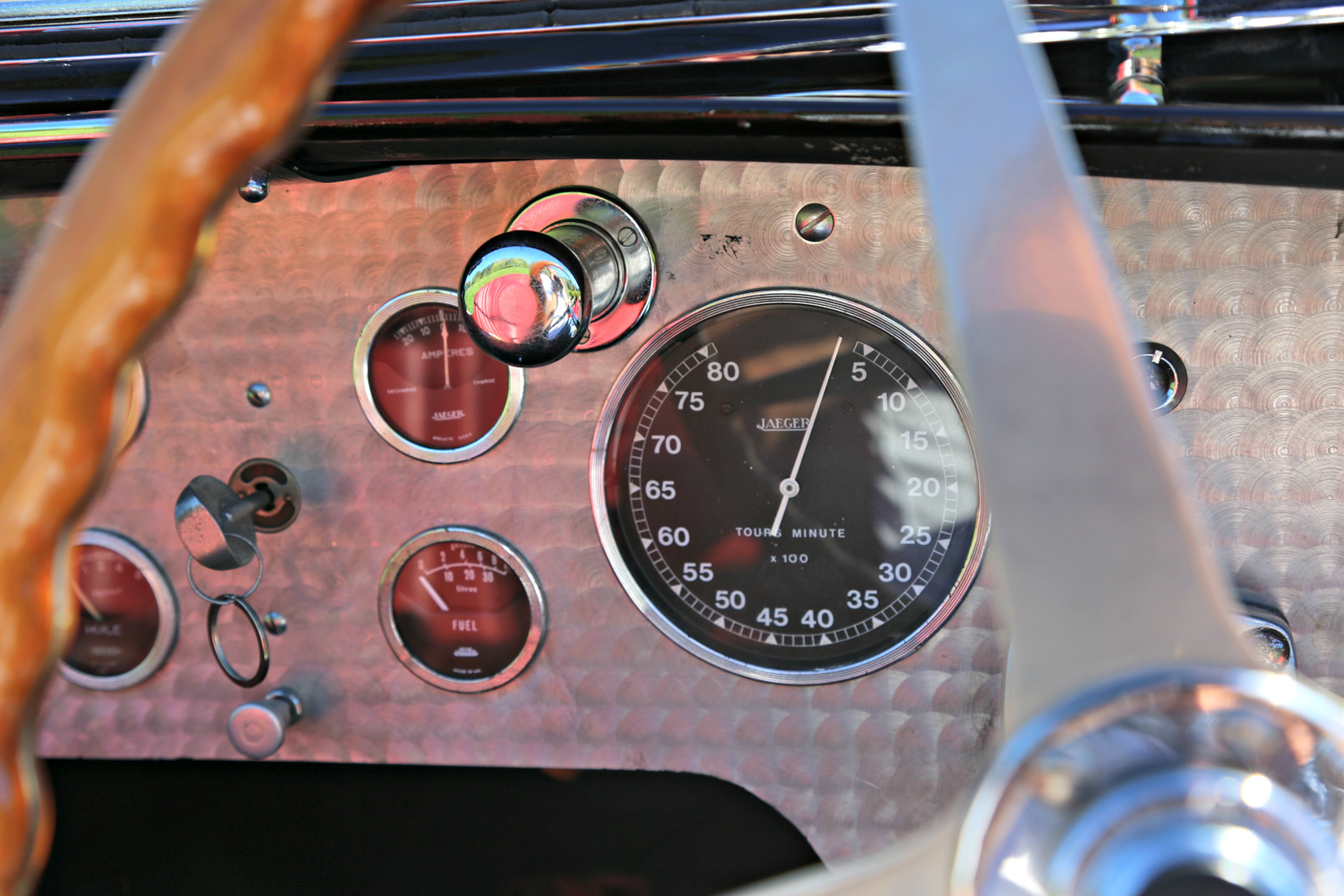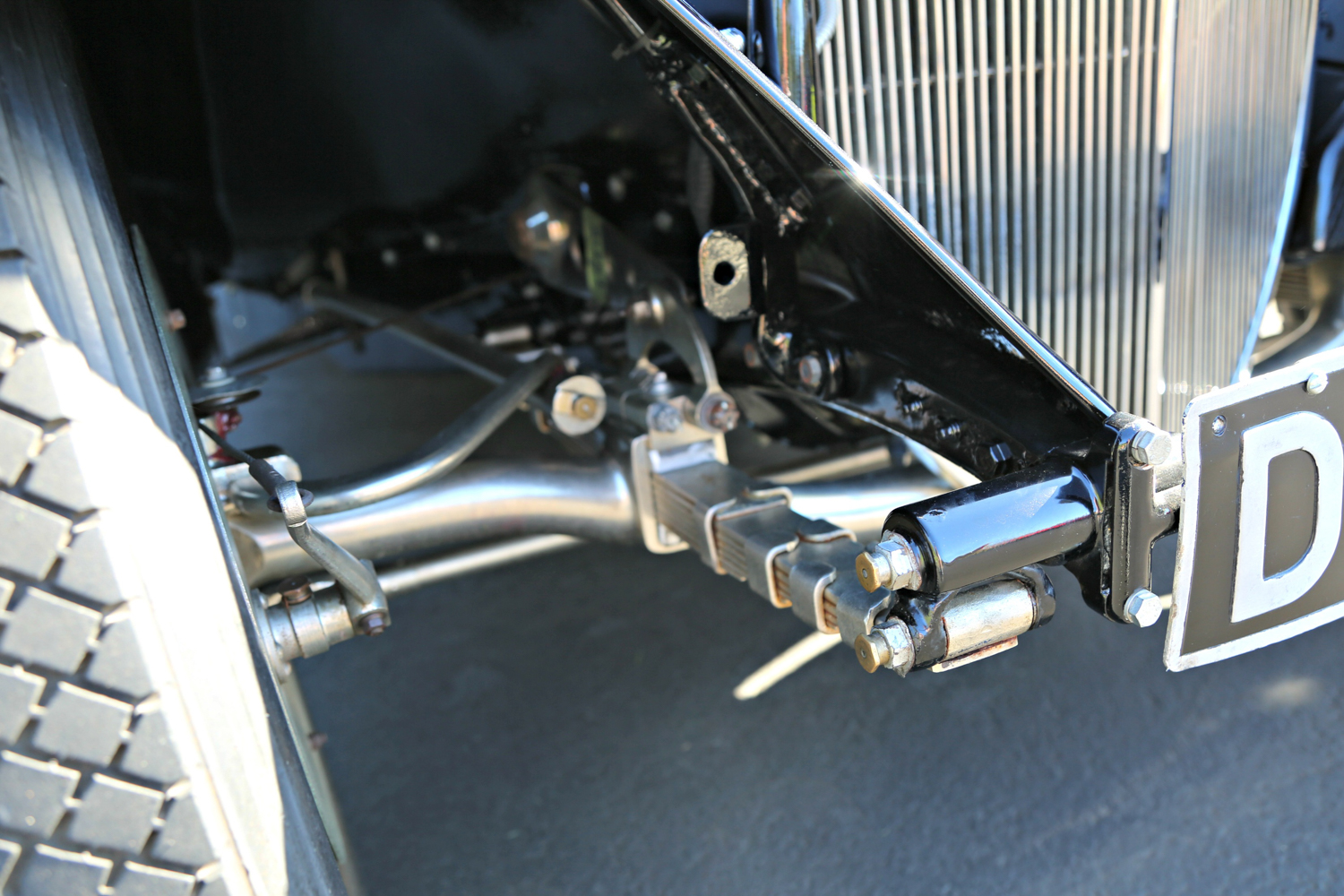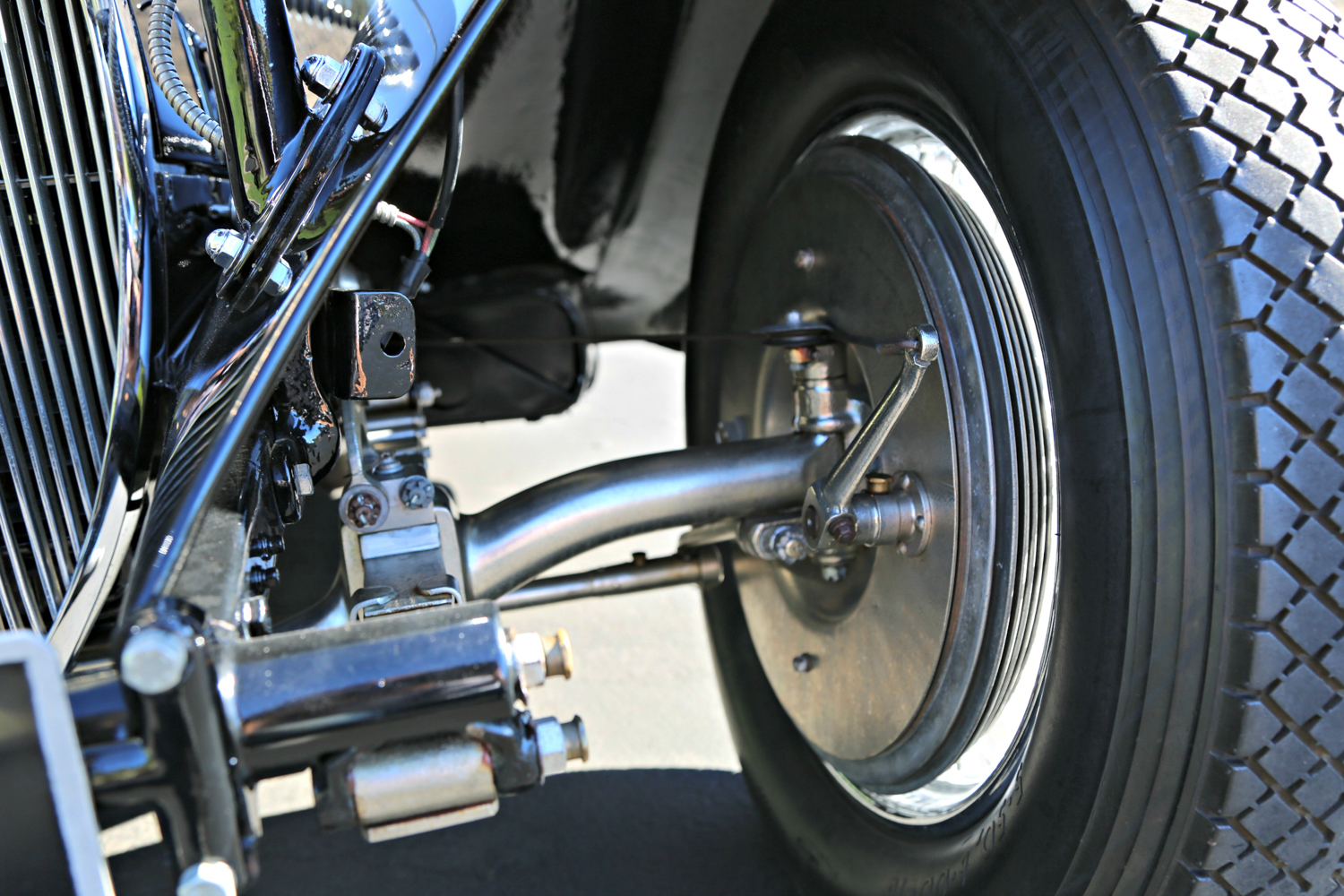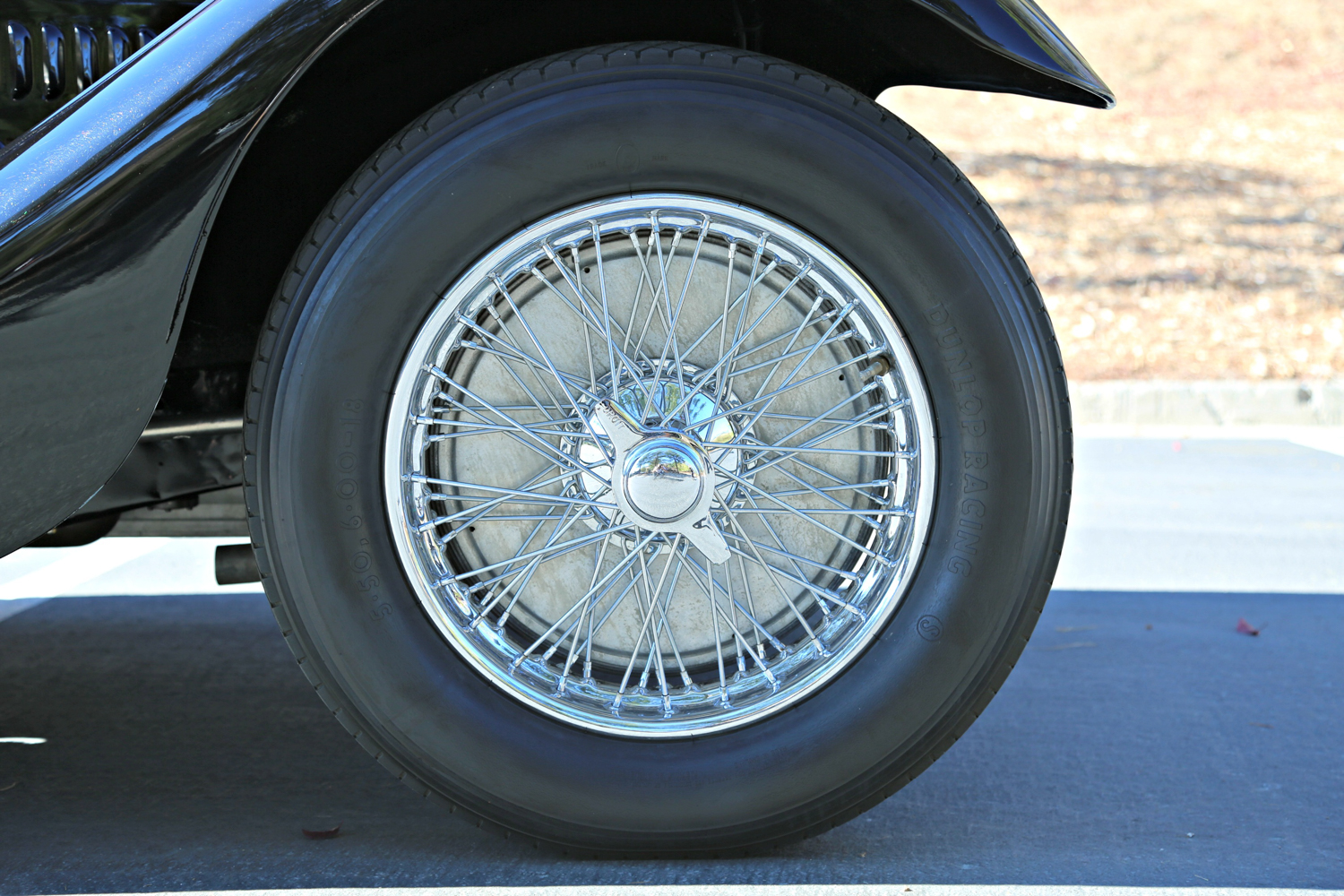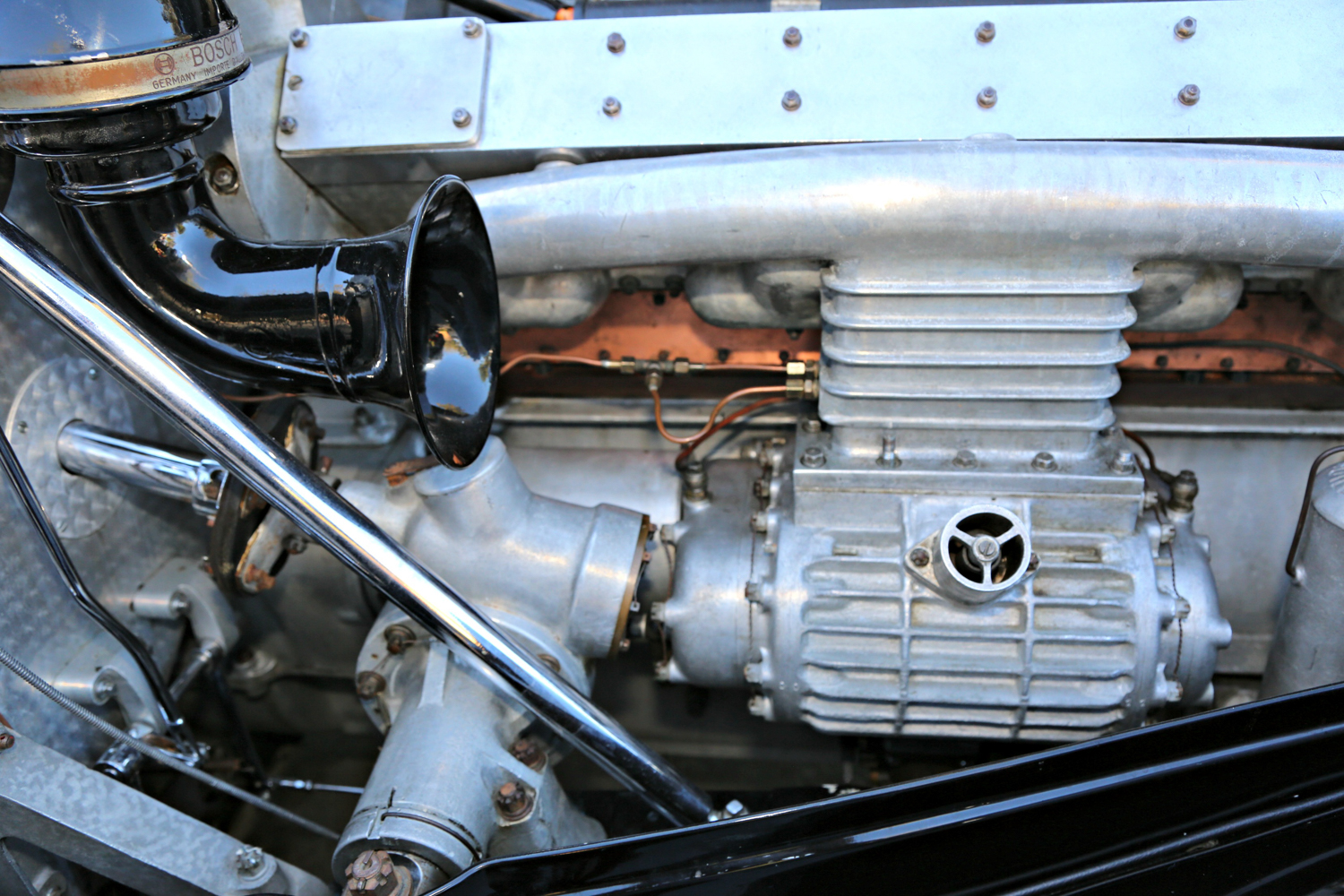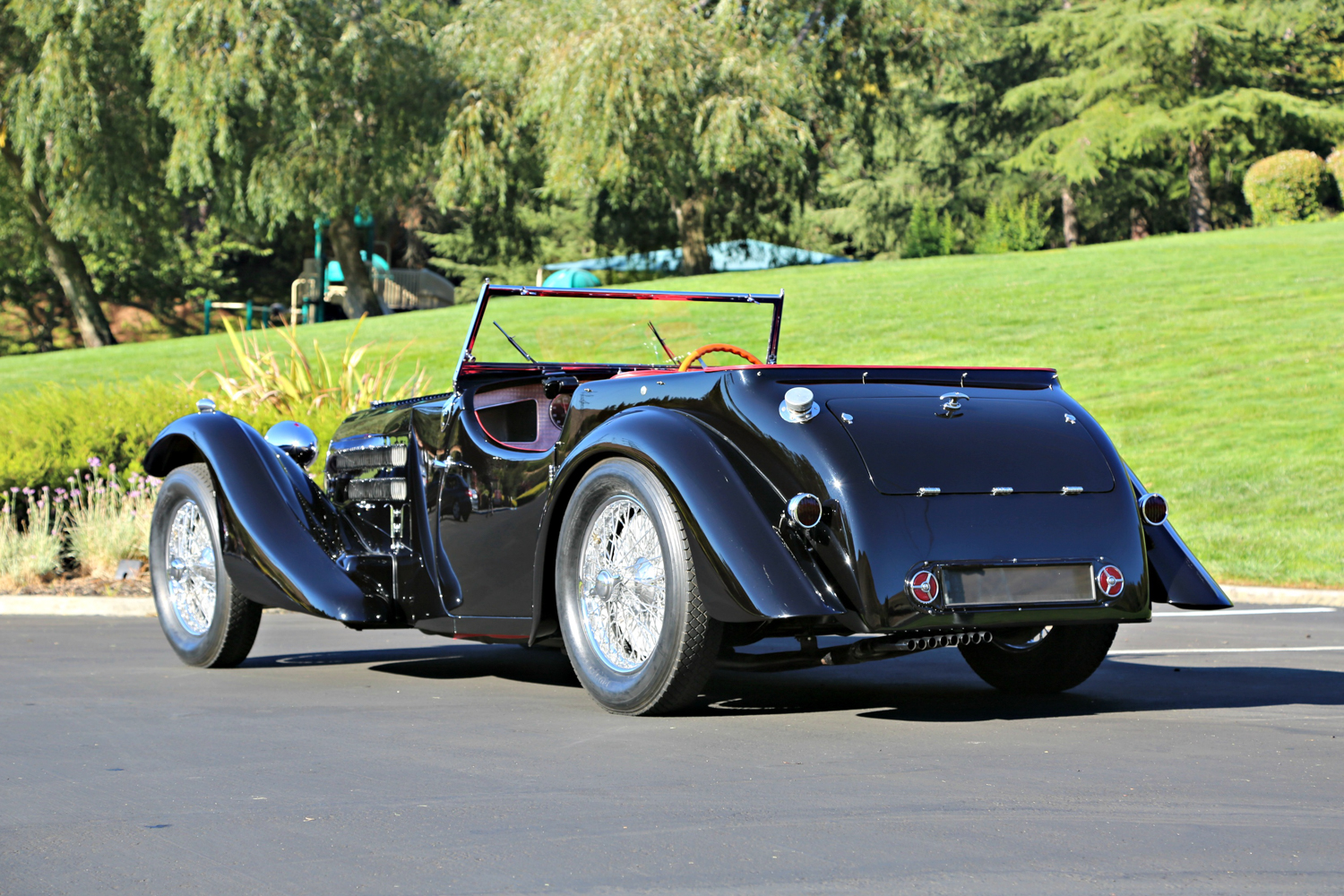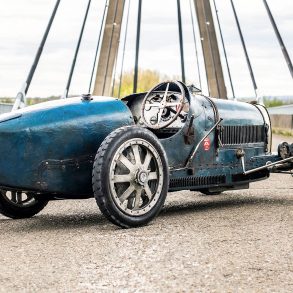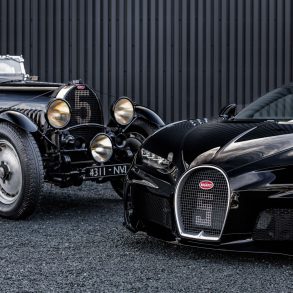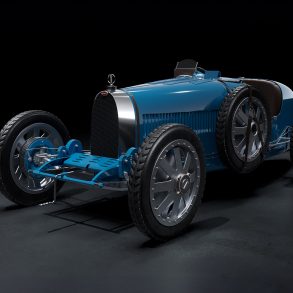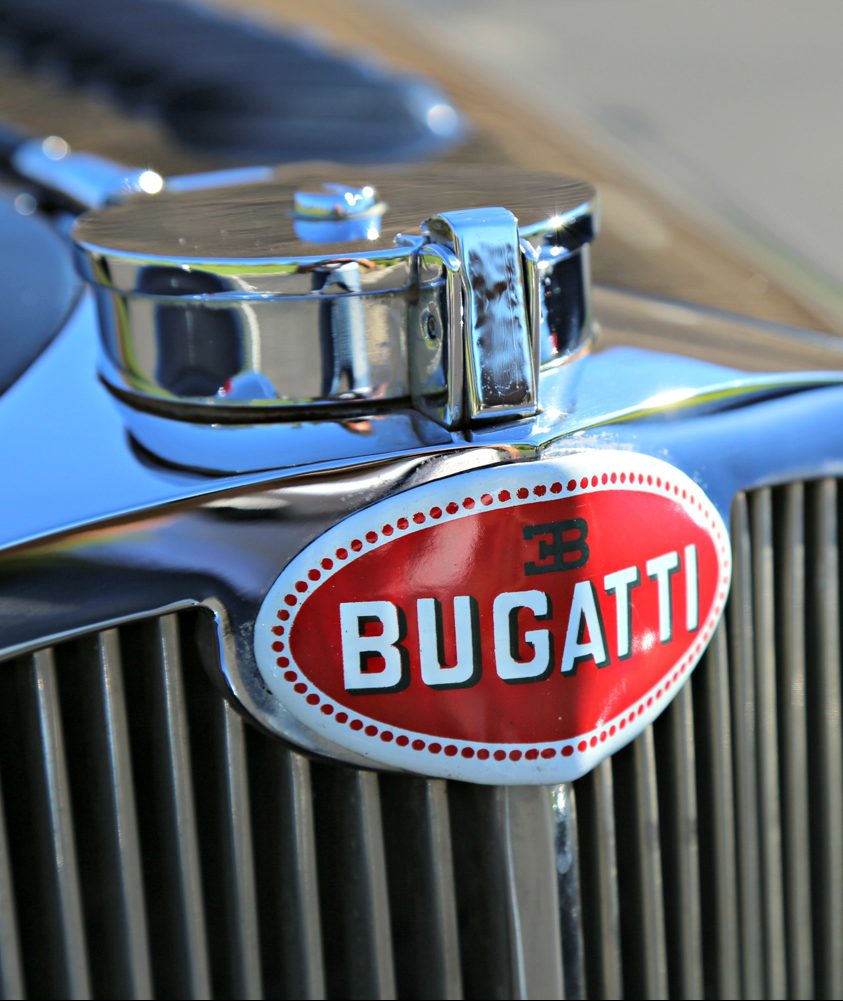
Introduced at the Paris Auto Salon in October of 1936, it was the second-series of Bugatti’s esteemed Type 57. The brainchild of Ettore Bugatti’s son Jean, the new Type 57 featured a powerful 3.3-liter, dual overhead-cam, eight-cylinder engine and a chassis derived from years of successful racing. Additionally, Bugatti presented two other interesting versions of the Type 57: the supercharged 57C (C for compressor) and the sporting 57S.
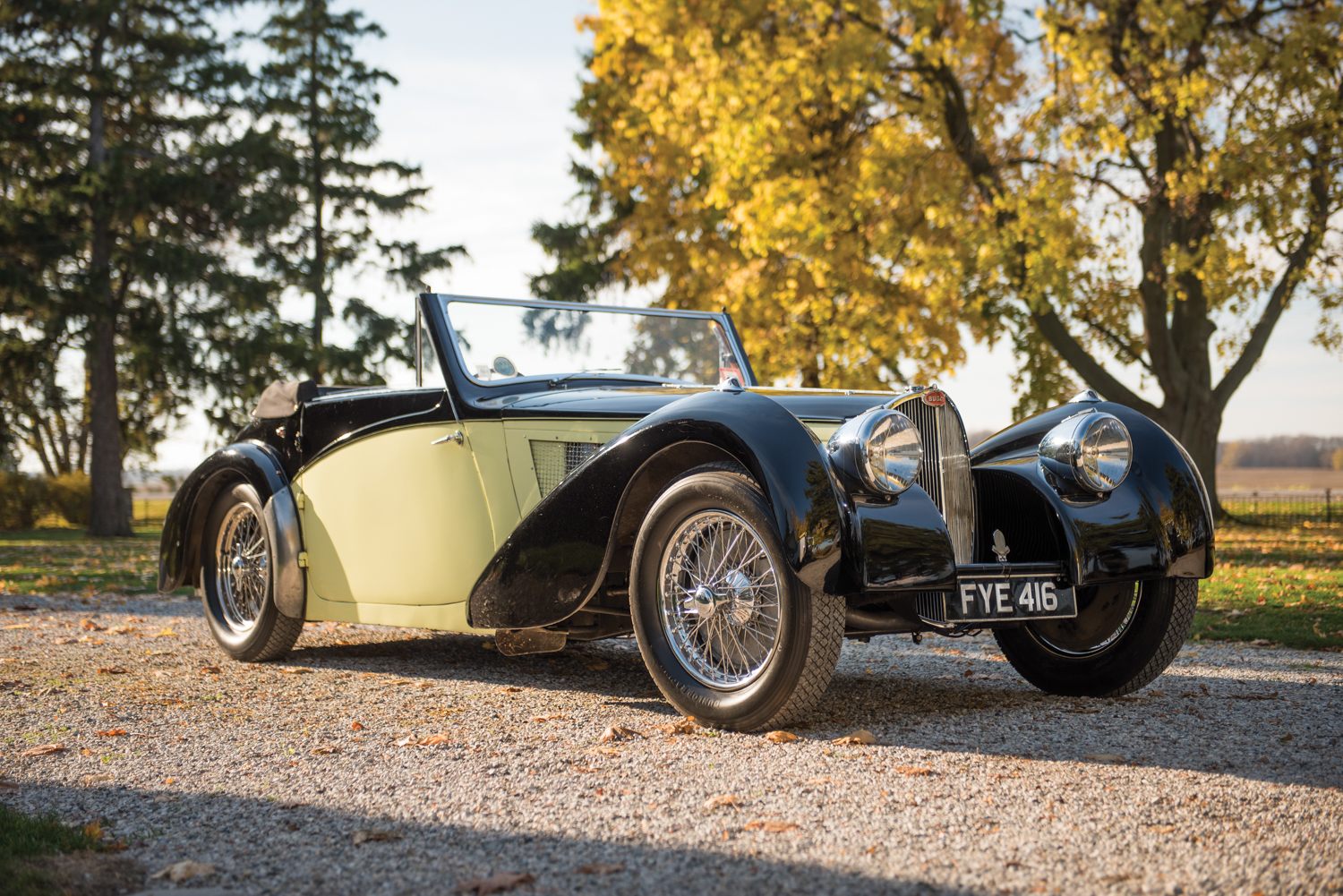
The Type 57S was constructed on its own uniquely designed chassis that was both shorter and lower (the S is for surbaisse, the French word for “lowered”). In order to achieve a lower stance, the front axle was articulated in halves, and the rear axle passed through the frame as opposed to under it. A magneto-driven ignition system was mated to the specially-tuned engine that had a higher compression ratio of 8.5:1 that was located low in the frame. A dry sump oiling system was designed to accommodate for the engine’s lower center of gravity to achieve acceptable road clearance. The radiator was mounted low as well, with Bugatti’s famous rounded radiator shell, but now with a more aerodynamic V-shaped grill.
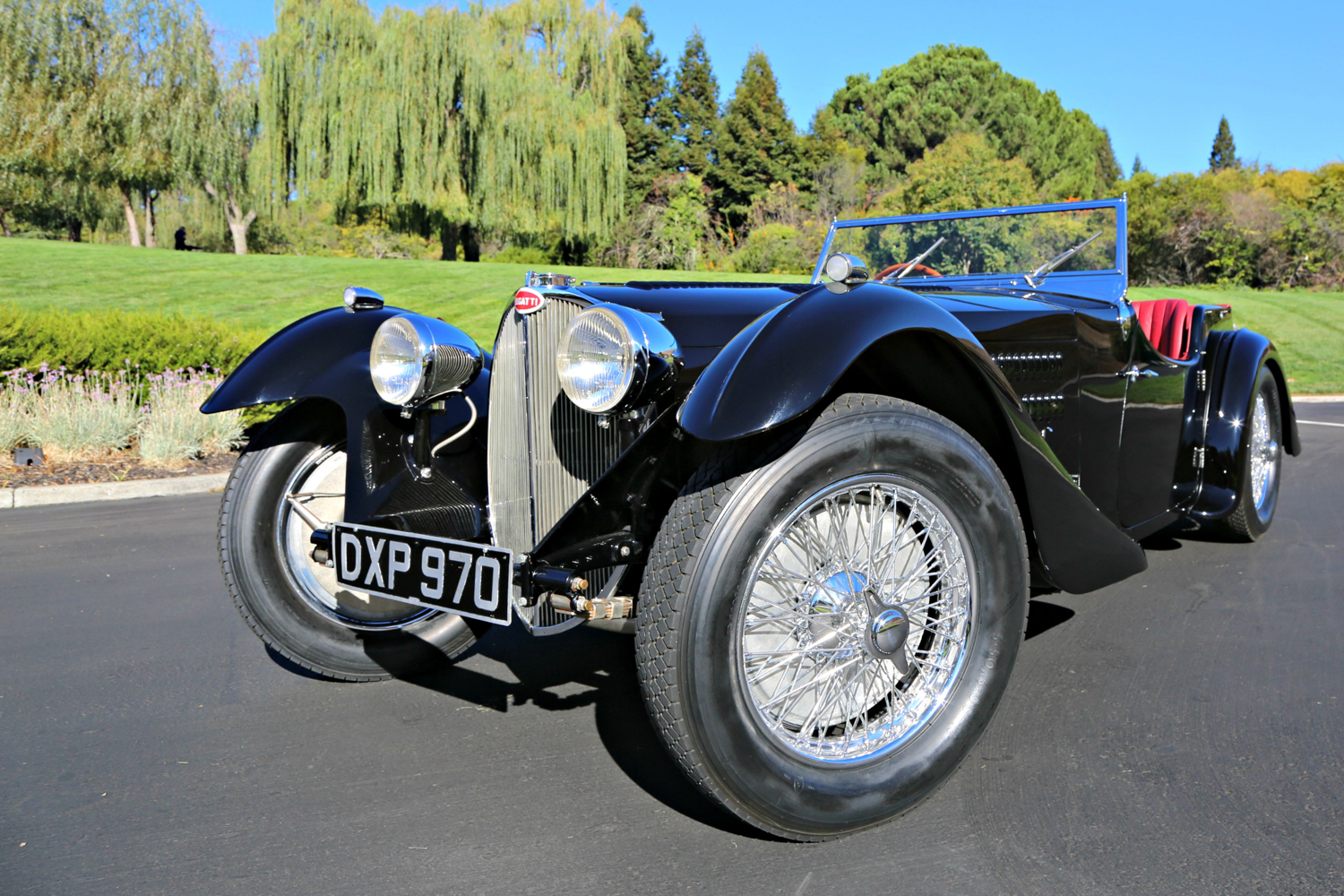
These cleverly engineered changes resulted in a significant increase in both horsepower and overall performance over the normal Type 57 engine and chassis. The 57S was rated at 175 hp versus the standard Type 57 output of 135 hp, and when specifying the optional “C” Roots-type supercharger, power output was boosted to 200 hp. This made the properly equipped 57C capable of a top speed of around 120 mph, making Bugatti the fastest French production car of the era.
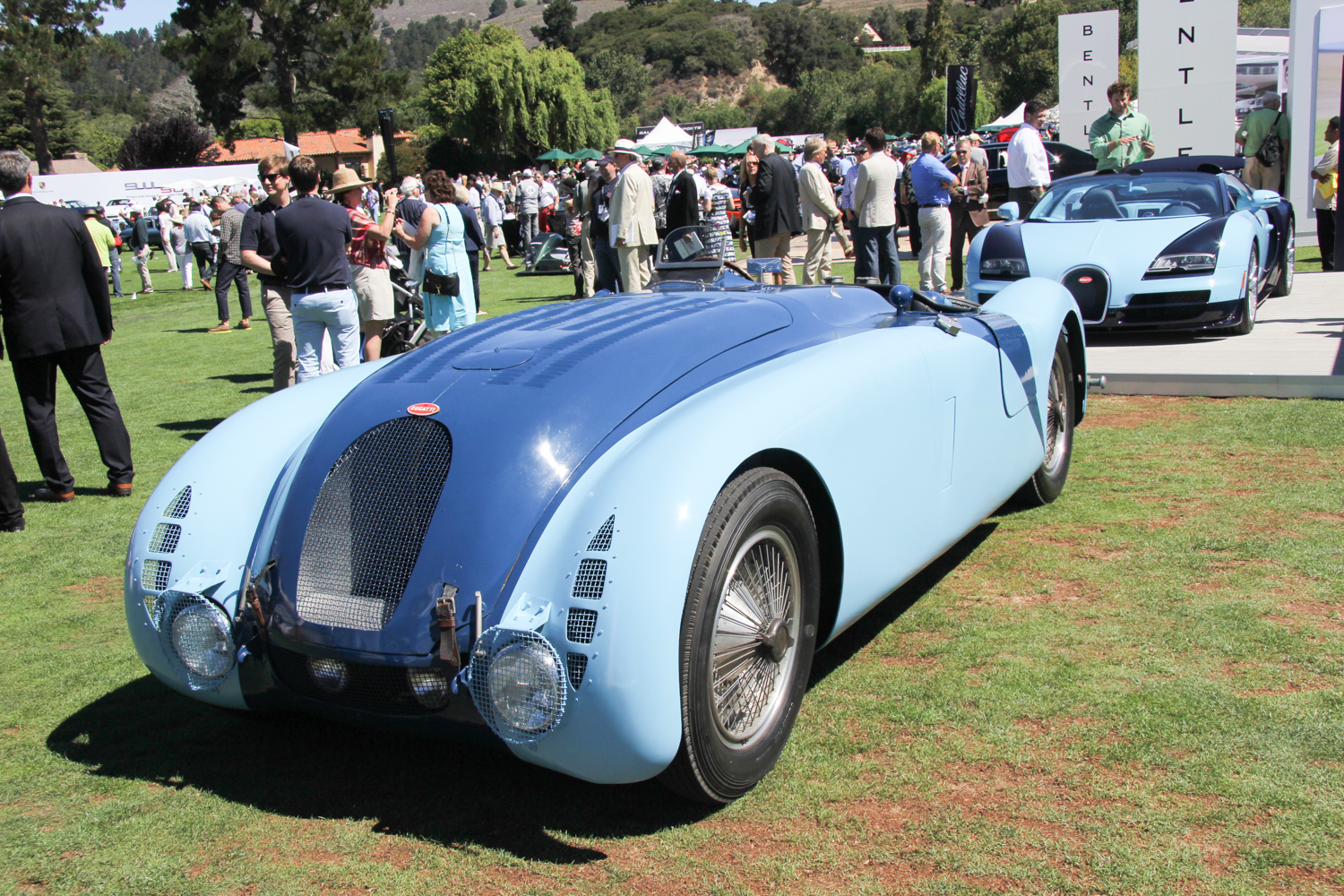
The sporting characteristics of the Type 57S chassis were utilized for Bugatti’s competition cars, with an advertisement published a year later coinciding with the 1937 Paris Salon that showcased how successful the Type 57S was in motorsports in its first 12 months. Capturing three racing victories during 1936 (the French Grand Prix, La Marne Grand Prix, and the Commings Grand Prix), Bugatti’s greatest competition achievement would come soon after when a technologically advanced aerodynamic version of the 57S referred to as the 57G “Tank” was victorious the 24 Hours of Le Mans in 1937. In addition to winning races at the Pau Grand Prix, Bone Grand Prix, and La Marne Grand Prix that same year, the 57S set records at 14 different motorsport events, including a speed average of 85.07 mph at Le Mans. A second overall victory at Le Mans was later repeated, in 1939, by new revised edition of the Tank.
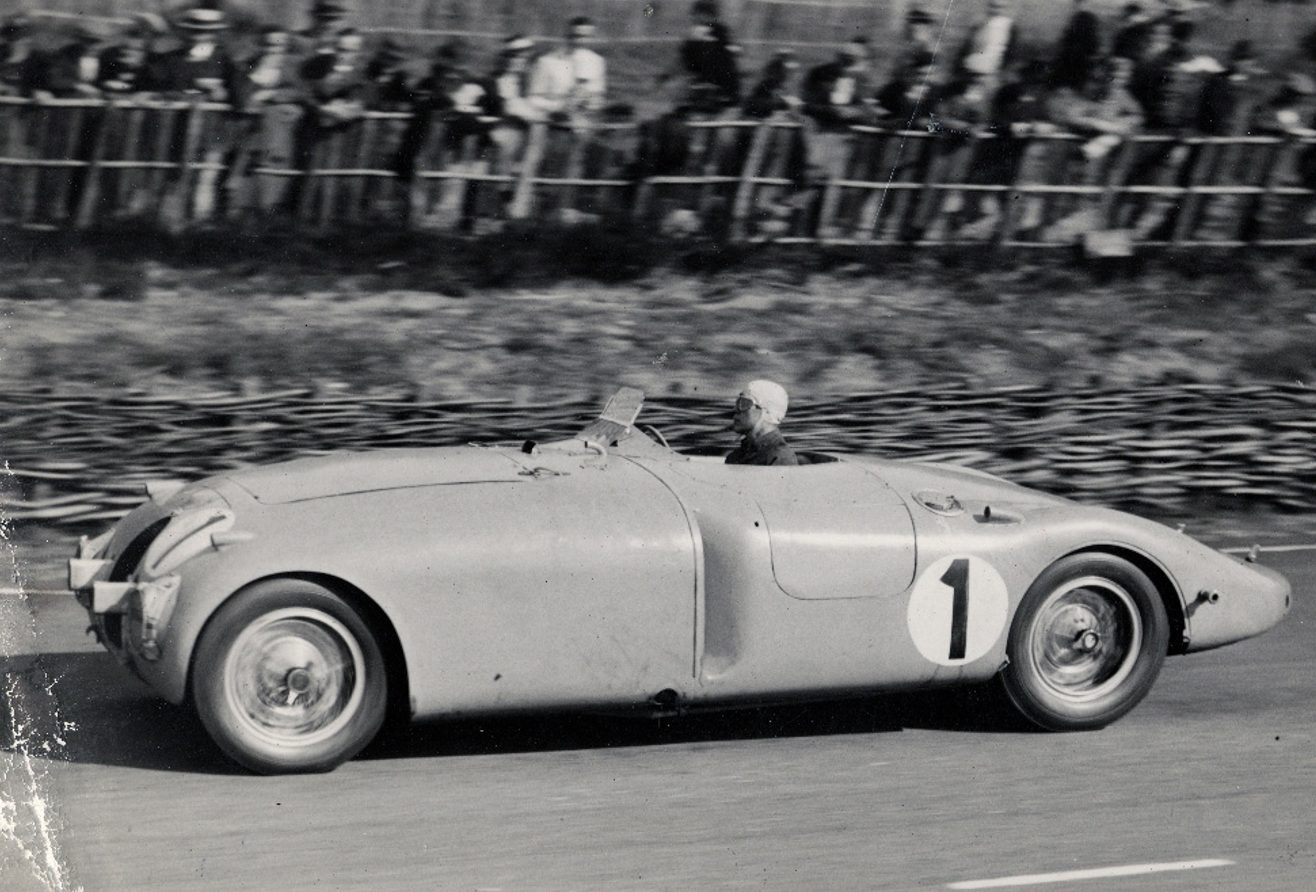
The accomplishments in the 57S’s mechanical design, engineering, and performance that evolved from lowering and shortening the chassis resulted in an additional benefit – the 57S provided the ideal chassis for some of the most strikingly beautiful body designs ever conceived. With the freedom to lower the hood and roofline proportions on the S chassis, stylists were able to radically change the entire profile of the body when compared to the taller profile of the Type 57. Each example of the Type 57S made is a study in the fine art of coachbuilding, and our feature car, chassis 57512, is an excellent example.
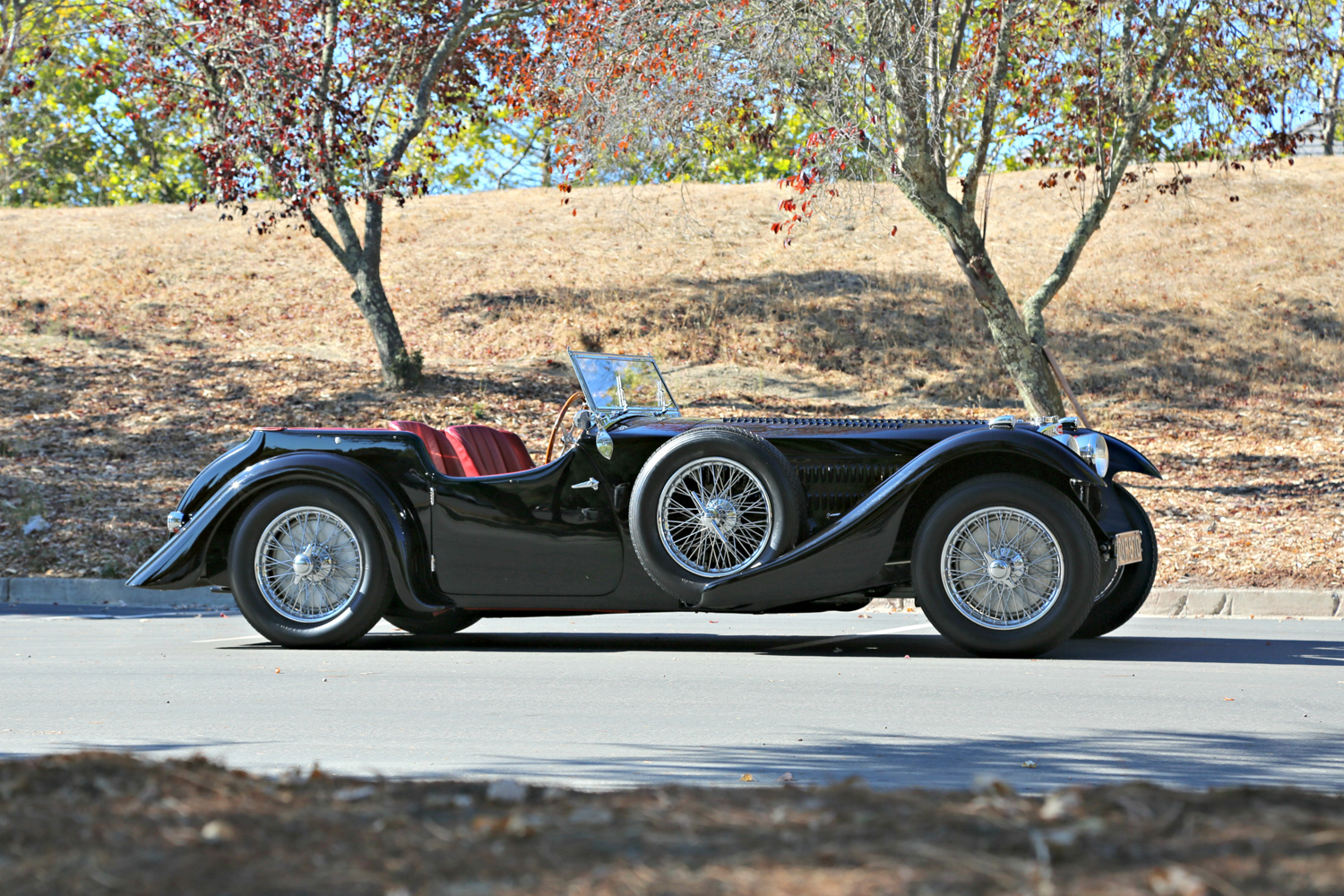
ENTER CORSICA COACHWORKS
Established at Kings Cross, London, in 1920 by Charles Stammers and his brothers-in-law, Joseph and Robert Lee, Corsica Coachworks was a relatively small company. They claimed not to have employed designers, preferring instead to directly carry out its customers’ wishes and ideas. Because Corsica was small and could closely cater to its customers’ desires, the workshop attracted many of the well-heeled sporting crowd. While little is known of the early ’20s Corsica creations, a good portion of it is believed to have been connected with Bentley.

Some of the best-known Corsica coachwork appeared in the 1930s, including a low-slung, racy sports body for the Double-Six 50 Daimler and an open two-seater for Donald Healey’s 1934 Triumph Dolomite, by which time the Corsica workshop had relocated to Cricklewood. Corsica also worked up a drophead coupe for a supercharged K-Type Magnette for MG general manager Cecil Kimber. In addition to traditional British marques Rolls-Royce, British Salmson, Frazer Nash and Lea-Francis, Corsica also worked on other European chassis, mainly Alfa Romeo and Mercedes-Benz.
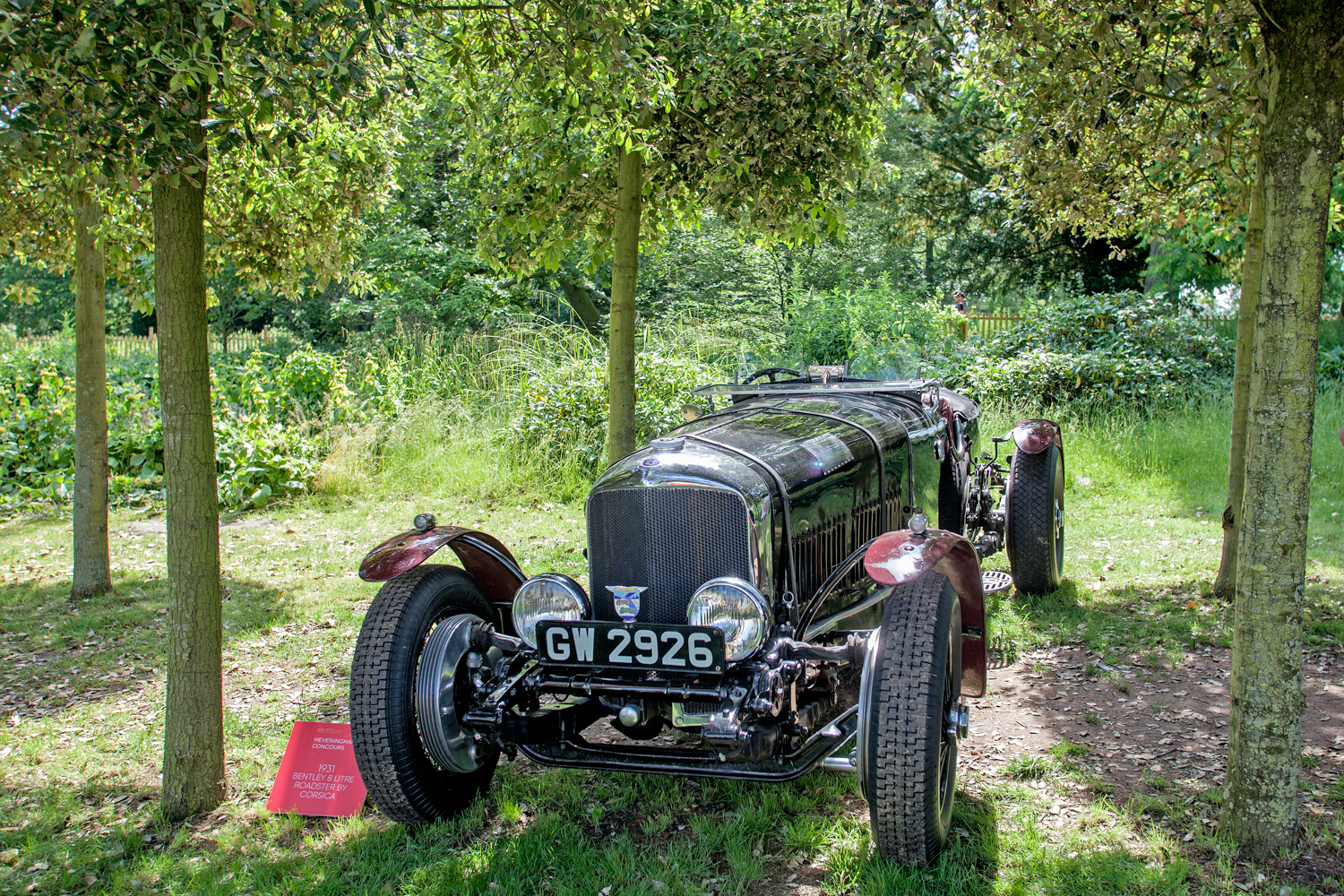
Later on, more than a dozen Type 57 Bugattis were fitted with bodies by Corsica, including a Type 57S roadster body for Sir Malcolm Campbell, the Grand Prix driver and land-speed record holder, as well as the famous Type 57S roadster crafted for Colonel Giles, who affectionately referred to his very special Bugatti as “La Petite Suzanne.” As with many of the great coachbuilders, Corsica ceased operation during World War II and would never re-open.
BUGATTI CHASSIS NUMBER 57512 IS CREATED AND BODIED BY CORSICA
The Type 57S was introduced in late 1937. A total of just over 40 production cars were constructed before production ended. The majority of these chassis were delivered with closed coachwork, such as the elegant Jean Bugatti designed Atalante coupe and the incredible Atlantic. Of the total number of 57S cars produced, only 16 examples were created with open coachwork.
French coachbuilding firms such as Gangloff (a favorite for executing some of Jean’s most recognized designs), Vanvooren, or Bugatti’s own in-house works fashioned most bodies. Other bodies were supplied by British coachbuilders such as Vanden Plas and Corsica, who applied their talents to the 57S with approximately as many as 15 chassis planned for delivery to the United Kingdom.
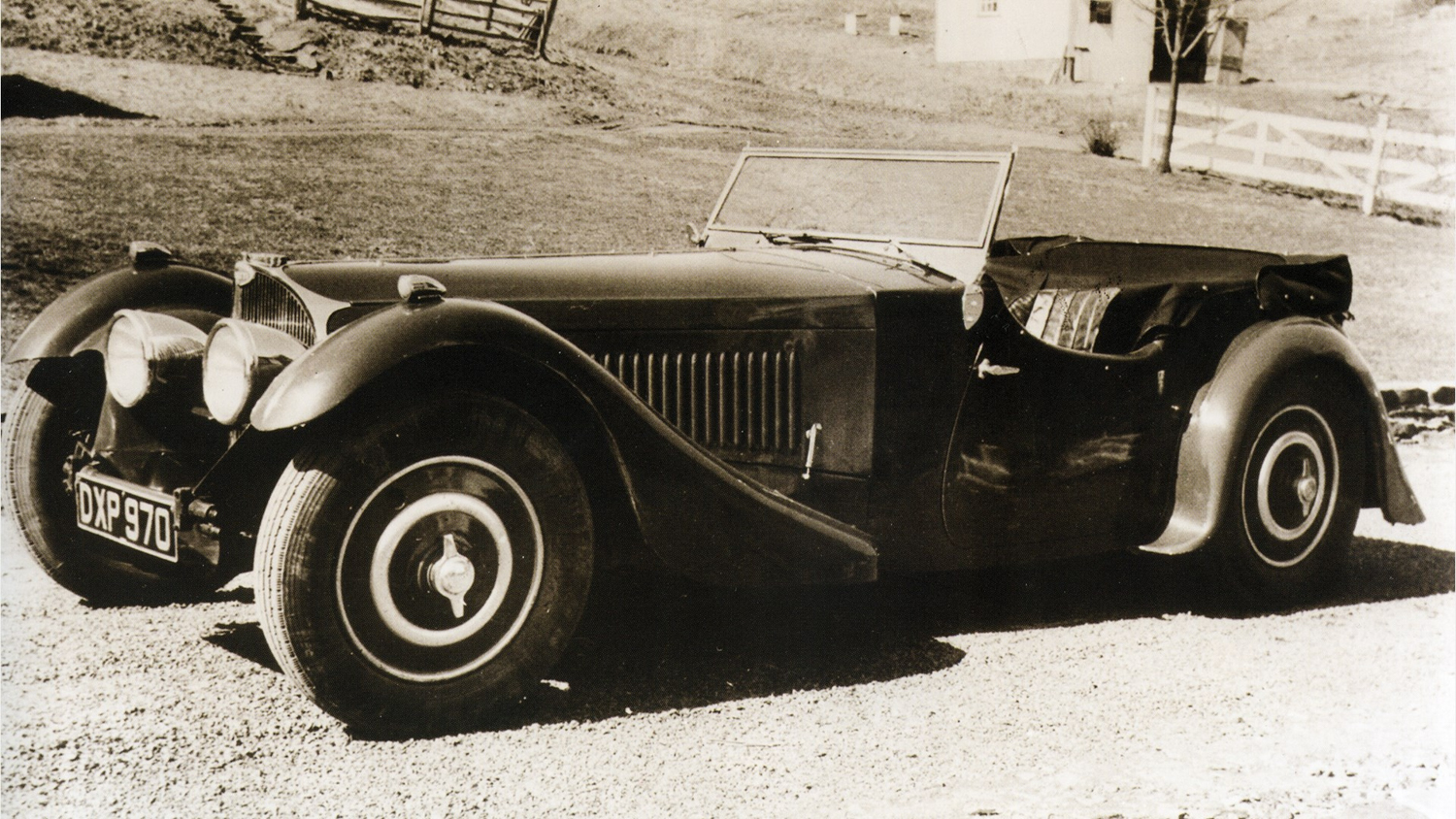
Corsica made a total of only eight bodies on the Type 57S chassis, which consisted of two closed car bodies (of which one example no longer survives), four two-seat roadster bodies (including the Sir Malcolm Campbell and La Petite Suzanne cars), and two four-seat tourer bodies. Chassis 57512 was the second four-seat tourer commissioned, with each being uniquely created to illustrate clear variations from one chassis to the other. The first chassis, no. 57503, abruptly ends the curve of the fenders just behind the wheels, with the oil tank located conspicuously just behind the left front fender. The example featured here extends the length of the fenders front and rear to gracefully hide the oil tank and visually lengthen the car for a dramatic conclusion to the rear profile. The configuration of the side-mounts was also created differently for both of these cars, with the spare suspended mid-flank on 57503 rather than elegantly locating the side-mount into the extended driver side fender as is seen on this car.
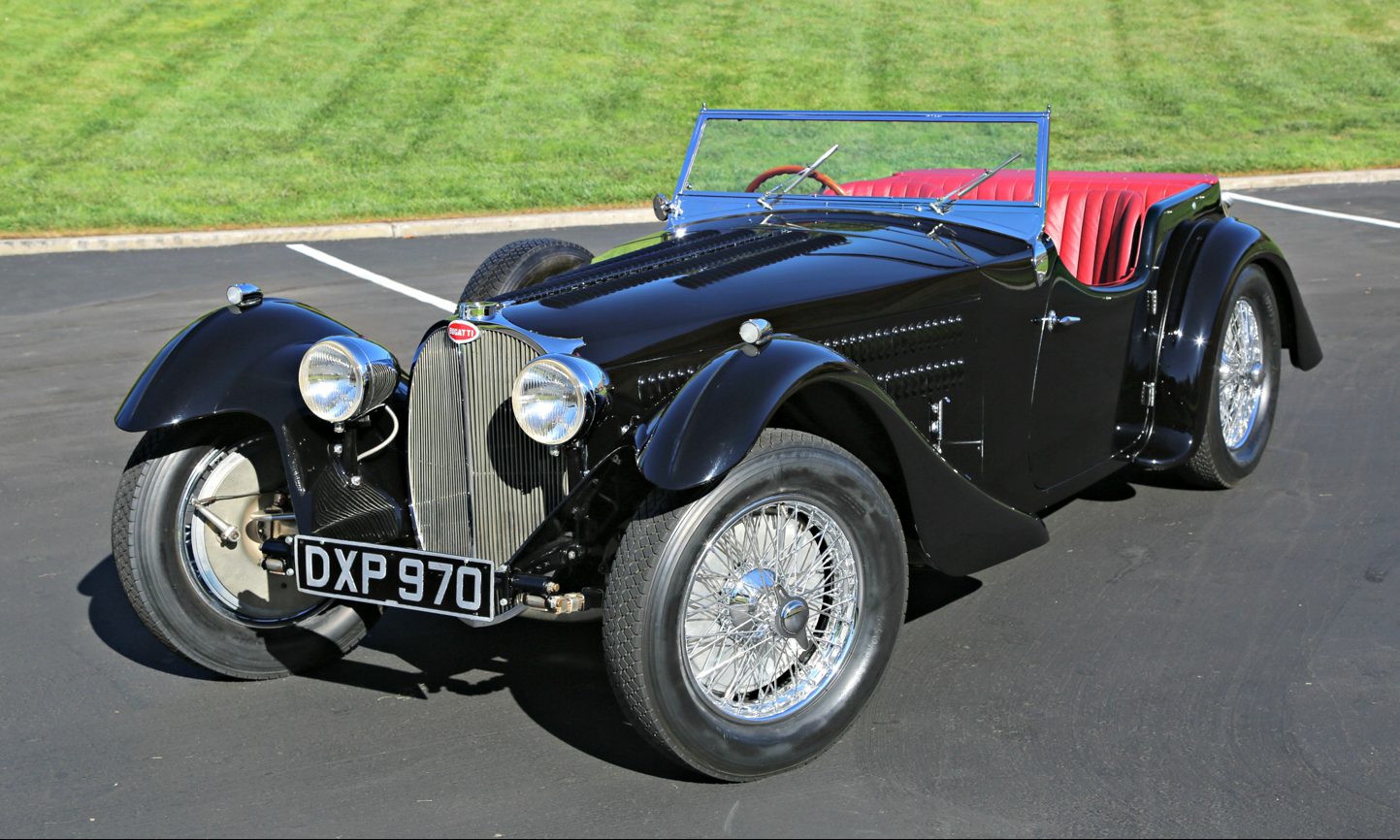
A quote from well-known Bugatti expert Johan Buchner further elaborates on the styling of 57512: “Comparison with 57503 reveals the totally separate identities Corsica achieved by differing the treatment of the wings, for what was, essentially, two very similar looking bodies. The left front wing hides the oil tank as successfully as 57503 displays it, while on the right, the single spare wheel nestles into the back of the wing with nearly as much visual delight as that provided by the suspended item on 57503. DXP 970’s front end treatment, while elegant, does not display the front suspension nearly as well as 57503, but this is merely my opinion. By no stretch of the imagination can she be considered as anything but a master-piece of late 1930’s automotive haute-couture.”
THE INTERESTING HISTORY OF CHASSIS 57512
This Type 57S Tourer history begins with the delivery of its chassis on March 8th, 1937, to Colonel Sorel at the Bugatti agency in London for Mr. Hubert Papworth, who operated a Bugatti tuning service in Fulham, London. Subsequently, the chassis was sent to the Corsica Coachworks to have the open four-seater tourer body fitted. Soon after Corsica completed the coachwork, 57512 was delivered to its first owner Mr. Maurice Fox-Pitt Lubbock, who registered the Bugatti in London with license DXP 970 in March 1937. Maurice Lubbock’s name was listed in the March issue of Bugantics, when he joined the B.O.C. Club, which also congratulated him on the purchase of his new Type 57S Bugatti.
Mr. Maurice Fox-Pitt Lubbock was a close friend of Jean Bugatti, who frequently drove him along the tight vineyard roads in Alsace at a very high rate of speed, each time Mr. Lubbock visited the factory. Perhaps due in part to Jean’s driving inspiration, Maurice also enjoyed exercising his new Bugatti in a spirited manner, even when carrying the family at speeds of 100 mph or better. One can imagine the heartbreak Maurice Lubbock experienced when he was forced to sell his prized Bugatti after being elected president of Rolls-Royce, approximately 10 years after he first took delivery. It is around this period that a photograph was taken of the car surrounded by eight other Bugattis including three additional 57S models in front of the Continental Cars Ltd. garage in Surrey.
By the time 57512 was sold directly from Lubbock to its next owner, Leonard Potter, the car had been fitted with a factory Roots-type supercharger. In a very informative book devoted exclusively to the Type 57S models entitled The Bugatti Type 57S -Evolution, Prototypes, Racing Cars Production, historians Bernhard Simon and Julius Kruta, report that the car was upgraded to 57SC specifications at the factory in 1939, while others, such as Pierre-Yves Laugier, suggest it may have been supercharged at Continental Cars Ltd. Either way, 57512 was upgraded to high-performance supercharged specification early in its history. Only two cars are known to have been fitted from the factory during production with superchargers, rendering them 57SC models. Most of the Type 57SCs were enhanced to supercharged specification sometime after their initial delivery, with a number of examples acquiring a supercharger many years later.
This Bugatti was offered for sale in the January 20, 1950, issue of The Autocar magazine by a company called “Speed Models” in London for the lofty sum of 950 pounds sterling. The ad read:
Bugatti Type 57SC, supercharged twin cam shaft, fitted most attractive streamlined open 4-seater body, articulated front axle with de Ram hydraulic suspension, road speed 135! In superb condition and believed to be the only example of its kind for sale in the country: unbeatable bargain. Brian Finglass. Bugatti Sales & Service.
Autocar magazine later reported in their “New and Views” section dated February 24, 1950, that the car had been sold by Speed Models and had been exported to New York accompanied by a photo of 57517.
After being shipped to a Mr. Thomson in New York, it was sold to an advertising executive named Walter Stocklin. Under Stocklin’s stewardship, 57512 participated in some of the first post-war racing events at Long Island, Bridgehampton, and Watkins Glen during the early 1950s. In 1955, Stocklin had the original Corsica coachwork removed in favor of an extremely low and lightweight two-seater racing body giving it a Bugatti Grand Prix car appearance. According to the previously mentioned Bugatti Type 57S book by Simon and Kruta, “Hiram Hillegas from Allentown, Pennsylvania had built the coachwork. Gus Reuter in New York was commissioned to do the painting and the interior: the body was blue with a red leather interior.”
In 1960, 57512 was acquired by well-known collector Judge John C. North of Easton, Maryland, when he found it advertised for $3,800 in the New York Times newspaper. Fortunately, Stocklin had retained the original Corsica four-seat Tourer body and it was included in the sale to Judge North. Surviving period photos show the car with Maryland historical plates 2451 and 729 Z8.
Judge North had a number of Bugattis, as well as some other classics in his collection and decided to keep the Hillegas Grand Prix-style coachwork on chassis 57512. North sold the Corsica coachwork in the mid-1960s to Allen Henderson, who intended to install the body on a much later Bugatti chassis with longer dimensions than what the Corsica body was designed to accommodate. Later, Henderson resold the coachwork to Walter Weimer after acquiring two more Bugattis from Judge North. Weimer subsequently sold the body to Ray Jones of Michigan, a well-known collector of Bugatti chassis, bodies, and spare parts. Jones sold the body to Lynn Steele from North Carolina, who ultimately sold the Corsica body back to Judge North. The sale included a modified Bugatti chassis and a spare 57SC engine, no. 23S.
A complete Bugatti 57S, using the original Corsica coachwork from 57512, the modified chassis and 57SC engine purchased from Lynn Steele, and a number of spare components sourced from Ray Jones was assembled by Judge North in the 1980s. North’s creation was then sold to Count Hubertus von Donhoff of Germany in 1986. Judge North bought back the assembled 57SC from Count Donhoff in 1998 and refitted chassis 57512 with its original Corsica coachwork after 43 years of being estranged and had it painted dark blue with black interior. After a short time the car was acquired by the Blackhawk Collection who commissioned Mike Fennel of Saugus, California, to perform a detailed restoration.
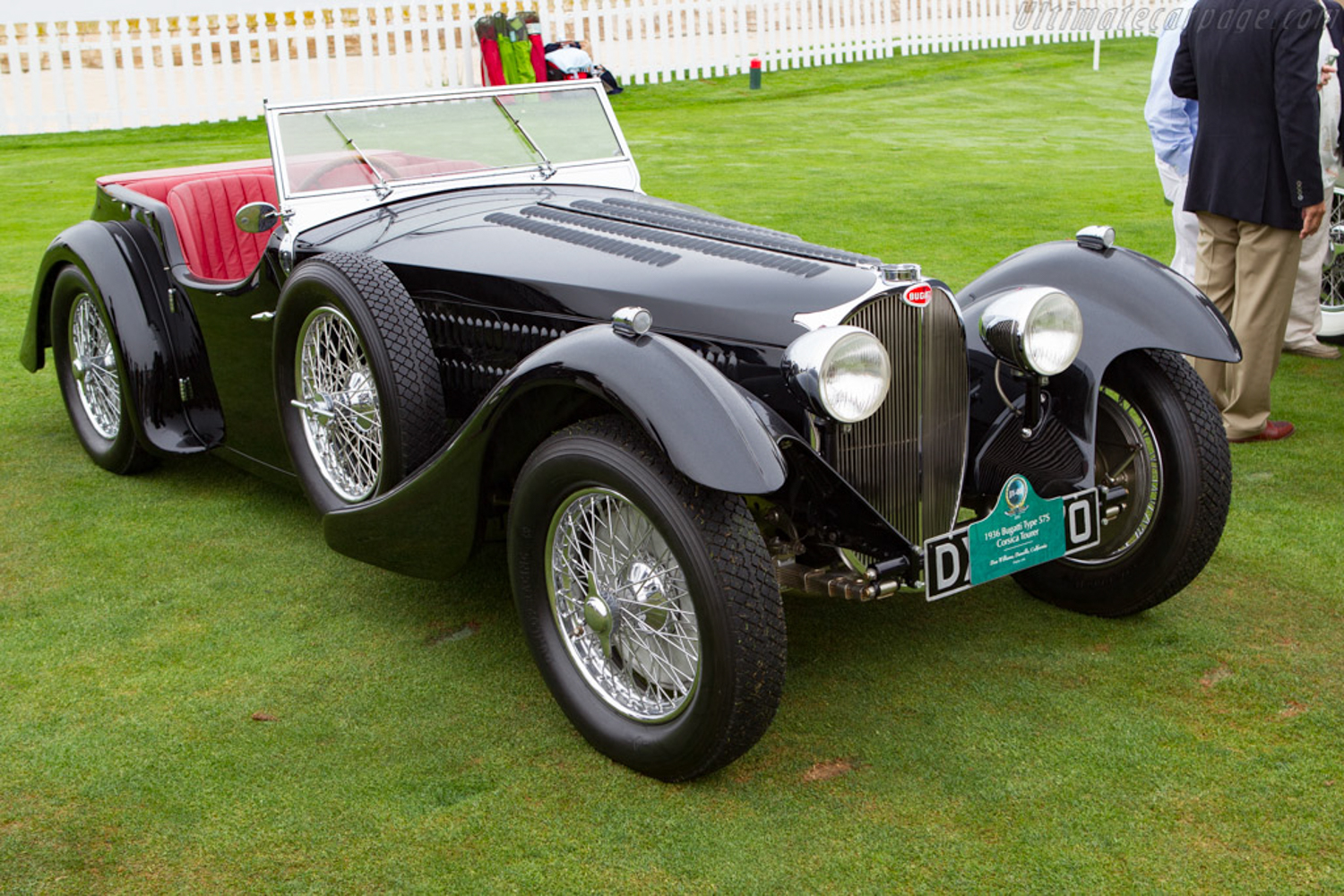
The car was exhibited on the lawn at Pebble Beach, in 2003, where Bugatti was one of the featured marques. The public and Bugatti enthusiasts at the internationally acclaimed event were delighted to see this exceptional car with its elegant Corsica coachwork being exhibited publicly for the first time in nearly 50 years. In recent years, 57512 has been displayed periodically at the Blackhawk Museum. Currently the car is still in the care of the Blackhawk Collection. [Editor’s Note: Since the time of writing, Chassis 57512 has now been offered for sale. Click here for details]
Today, 57512 still wears the restoration it had when it made its Pebble Beach debut and features its original chassis, engine, gearbox, and coachwork, with the supercharger believed to be the same one that was installed within the first few years of its life. Period photos of the car when it was new, show it with full wheel discs in lieu of the exposed wire wheels it rides on today. The original Corsica hood design featured a single row of elongated louvers on the hood sides and a solid non-louvered hood top. It is believed that the impressive number of louvers the car features today were added at the time the supercharger was fitted in 1939 to aid in cooling the powerful engine.
Bugattis from this period are exciting and exotic. Poised, elegant, sleek and powerful, they have always been sought-after and desired by collectors since they were new and they will be forever.


